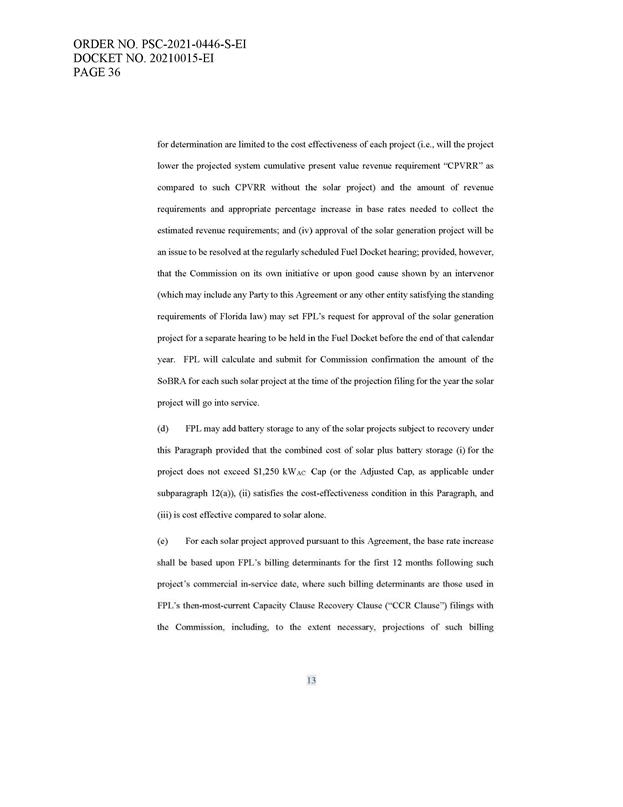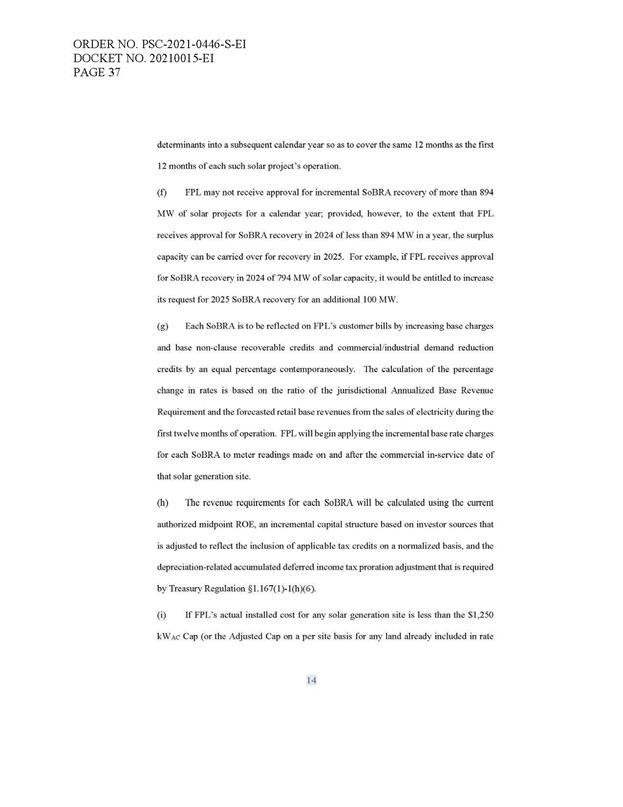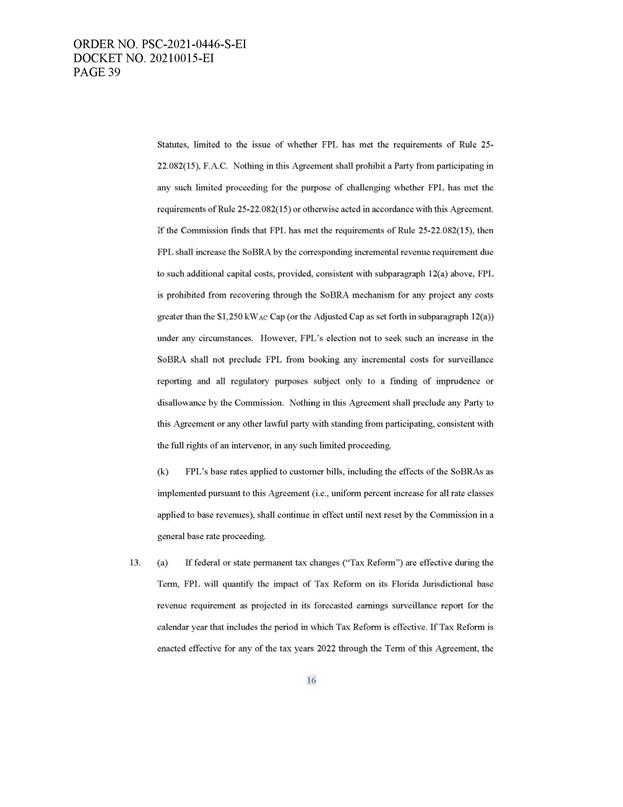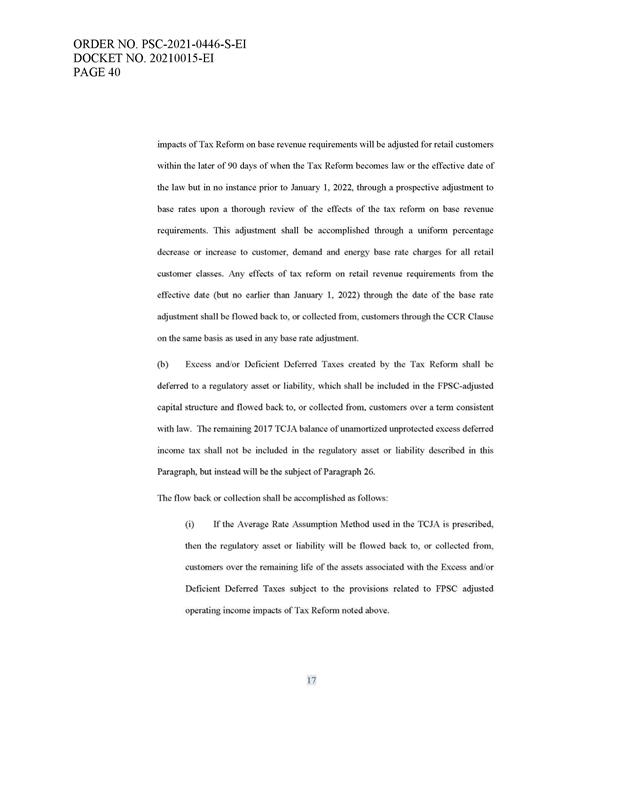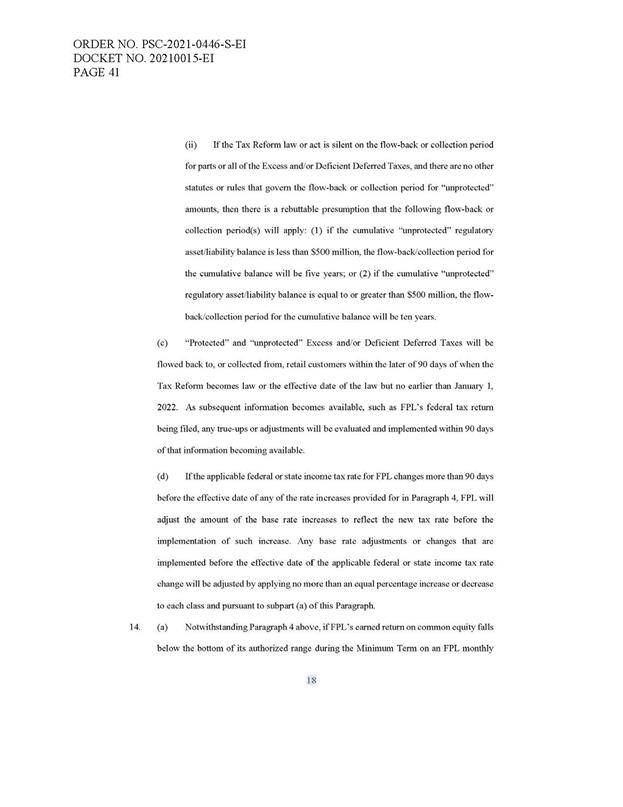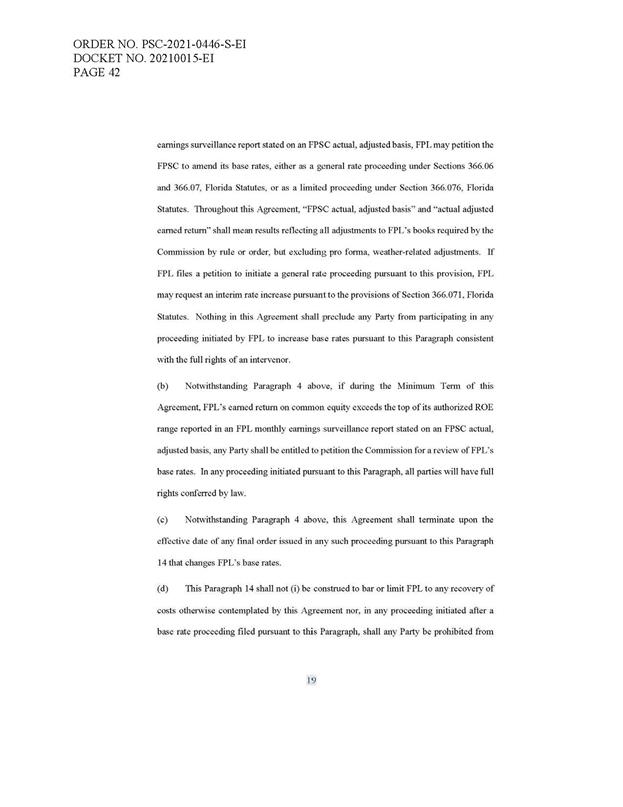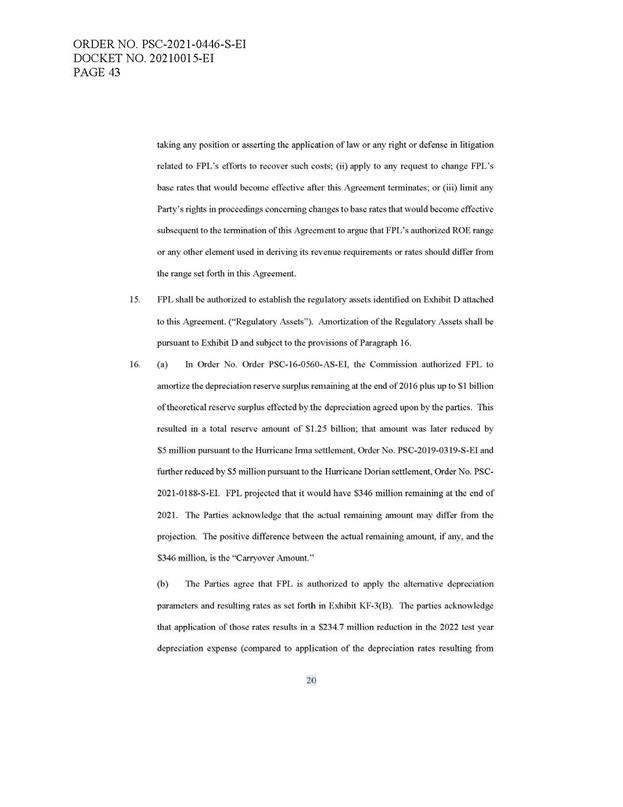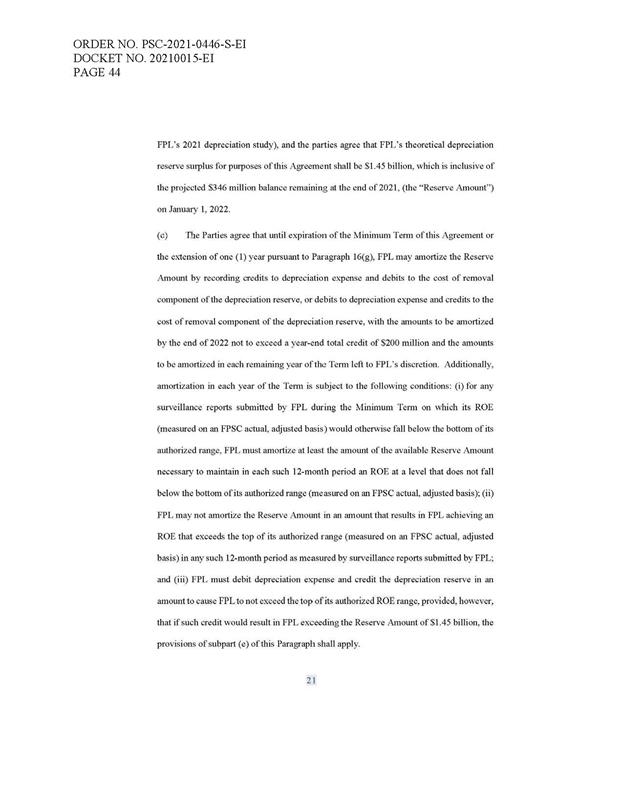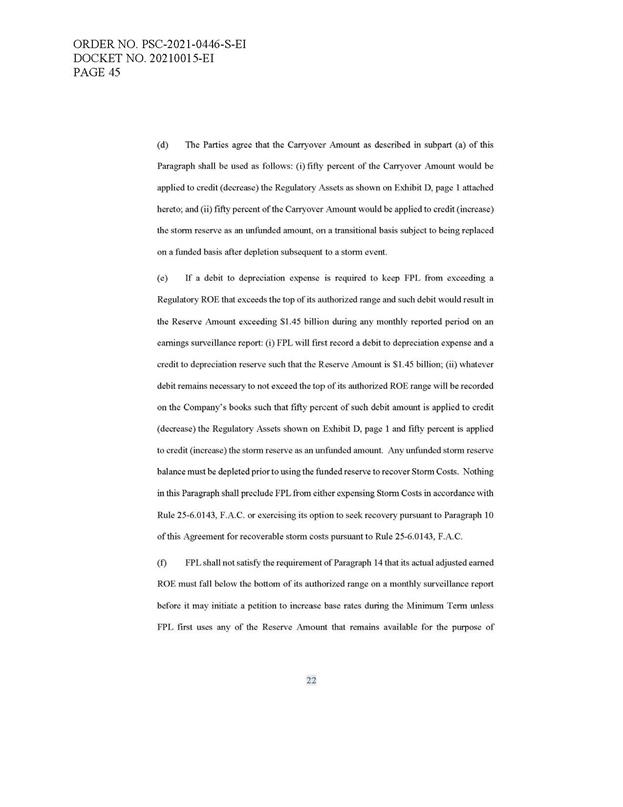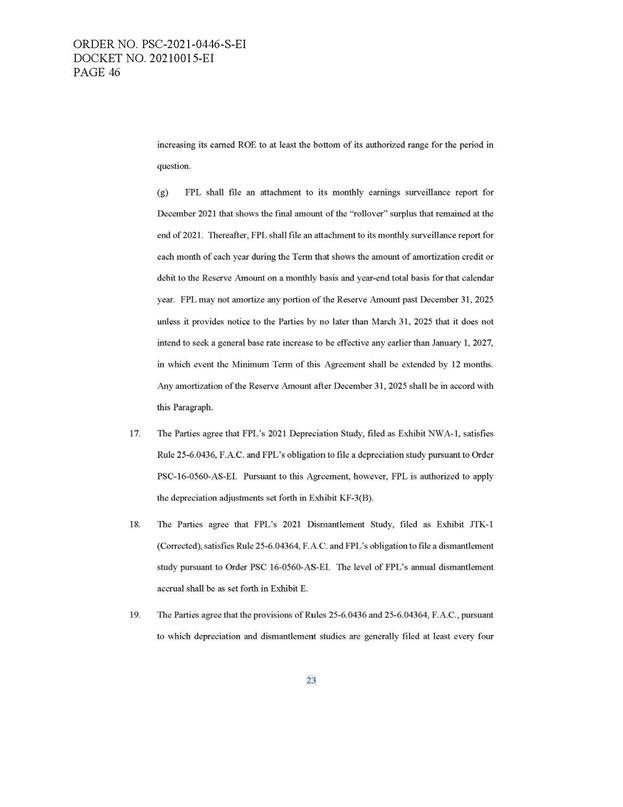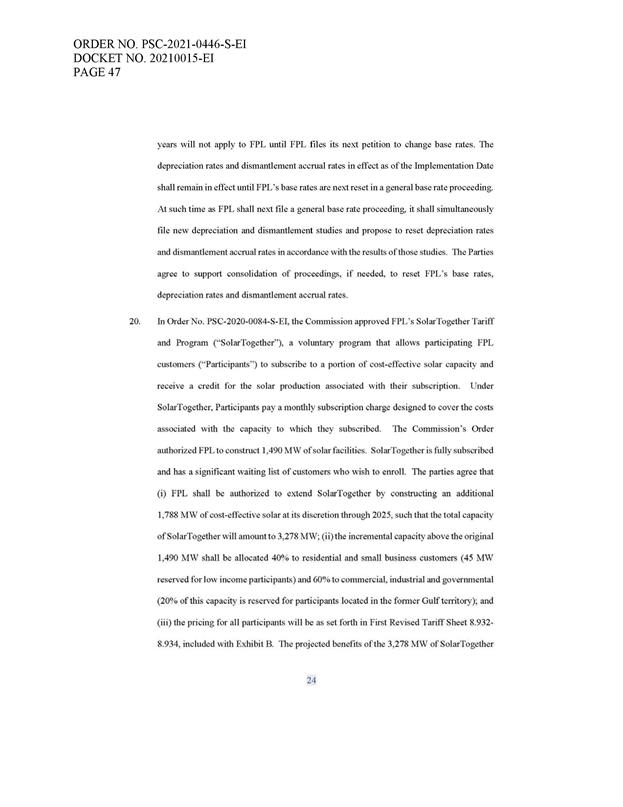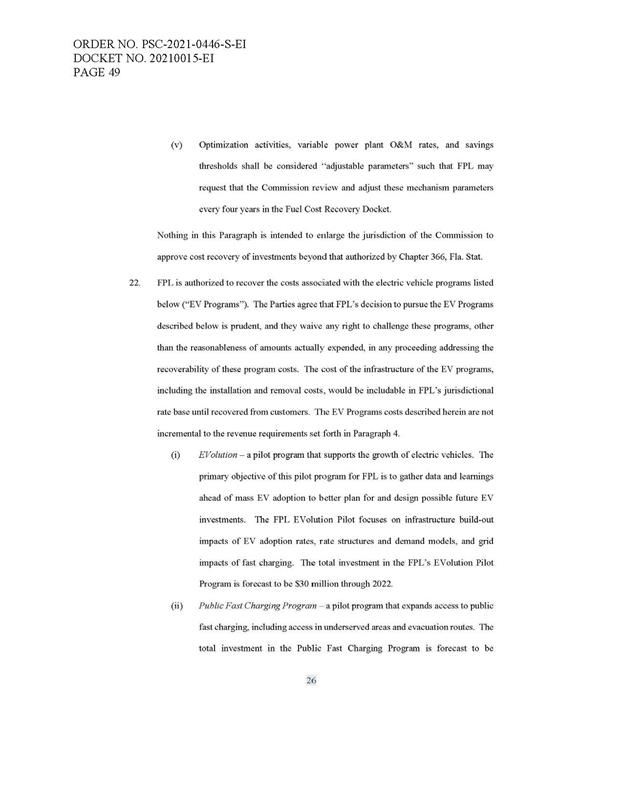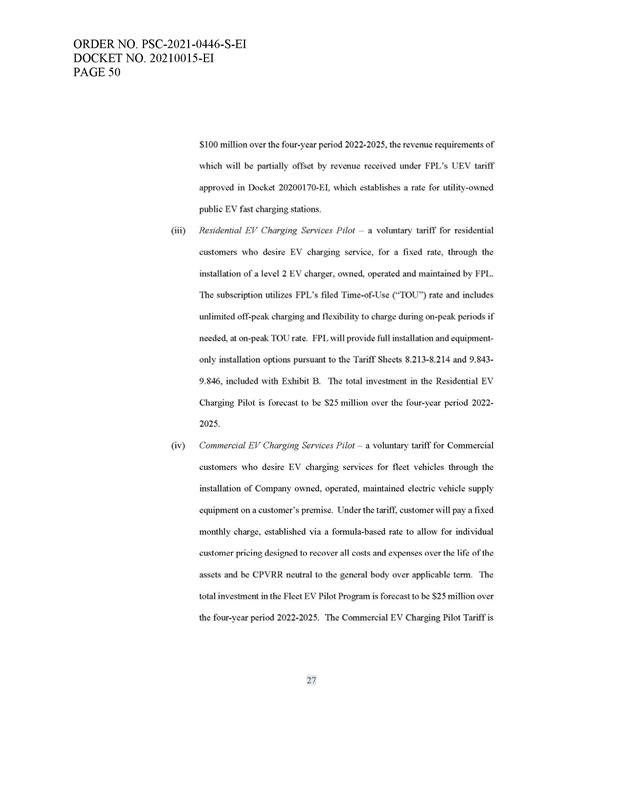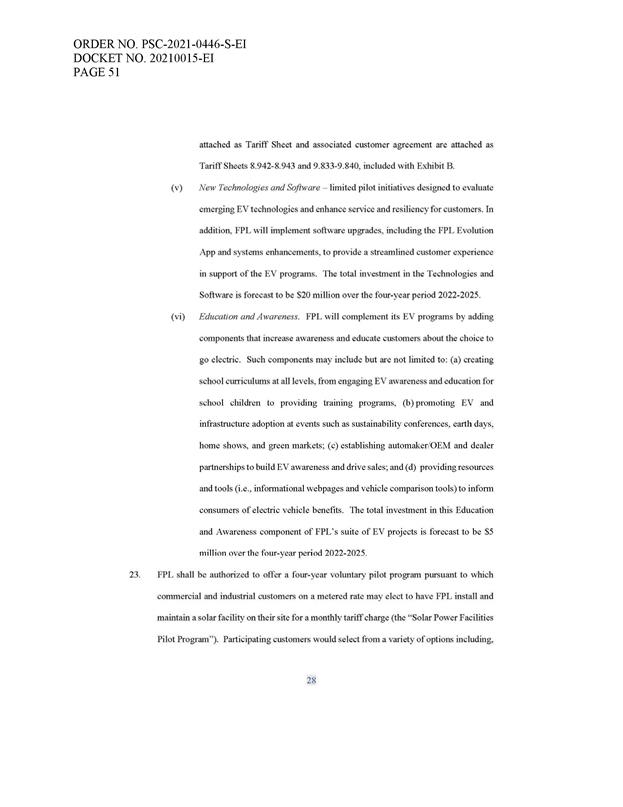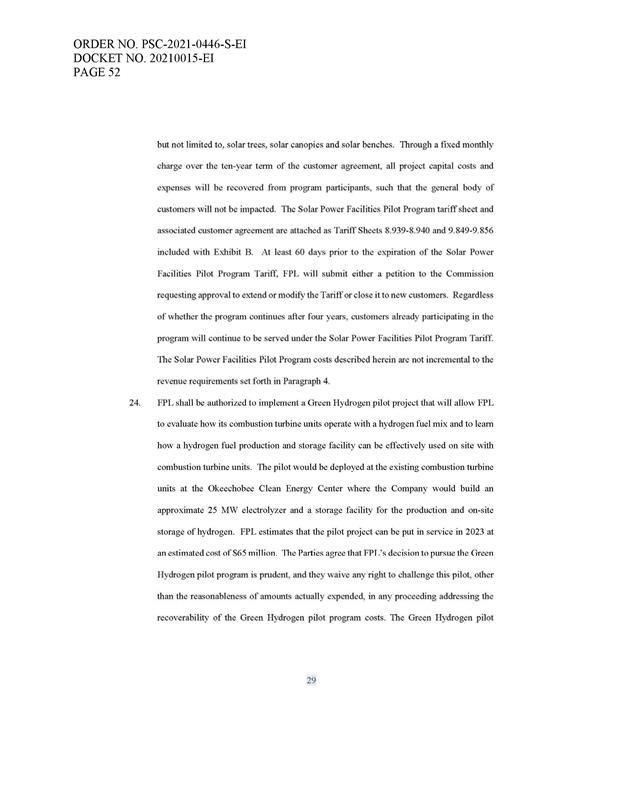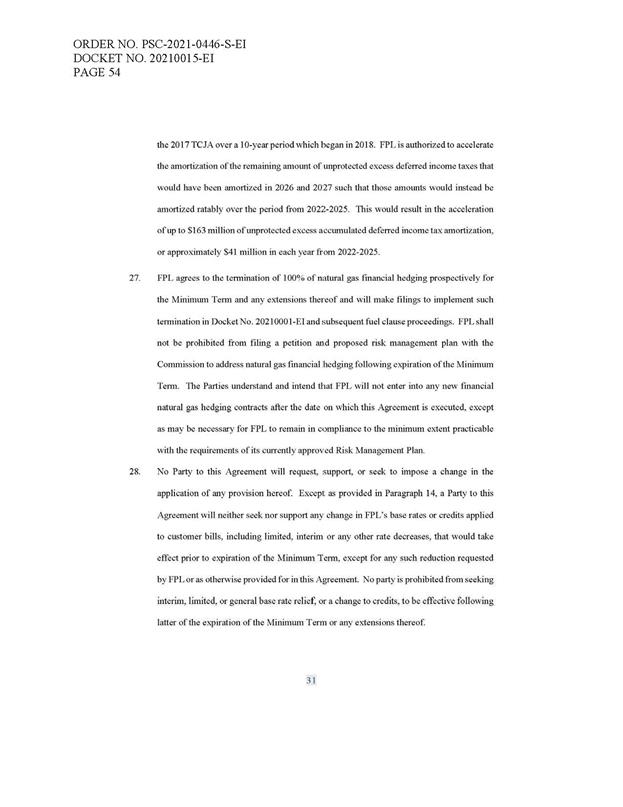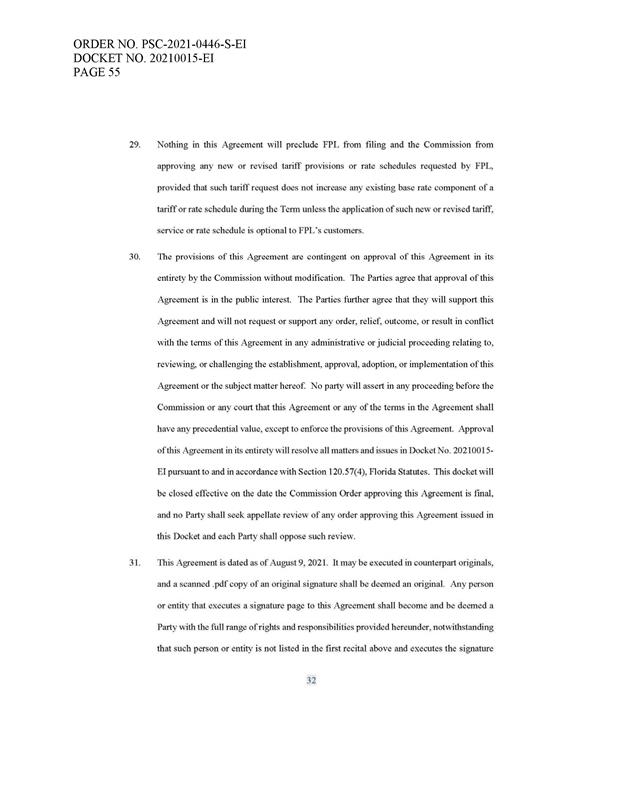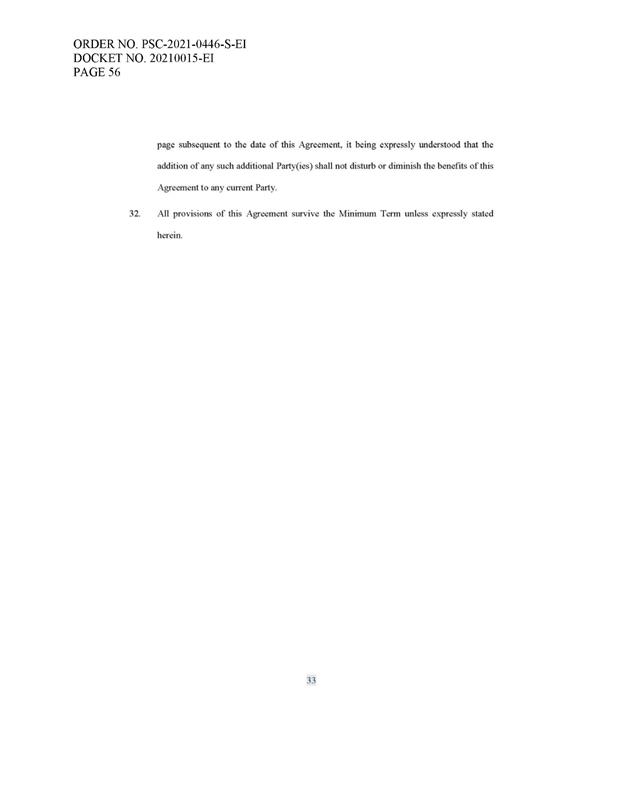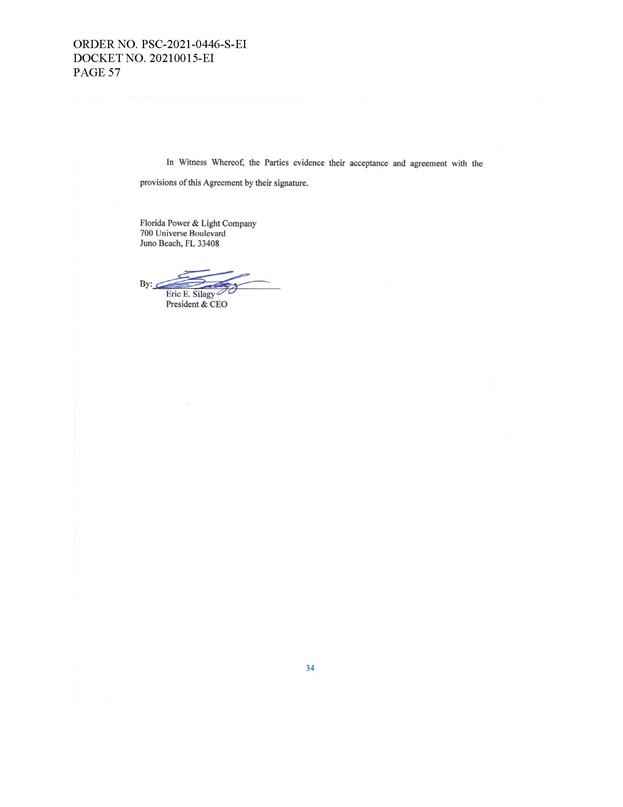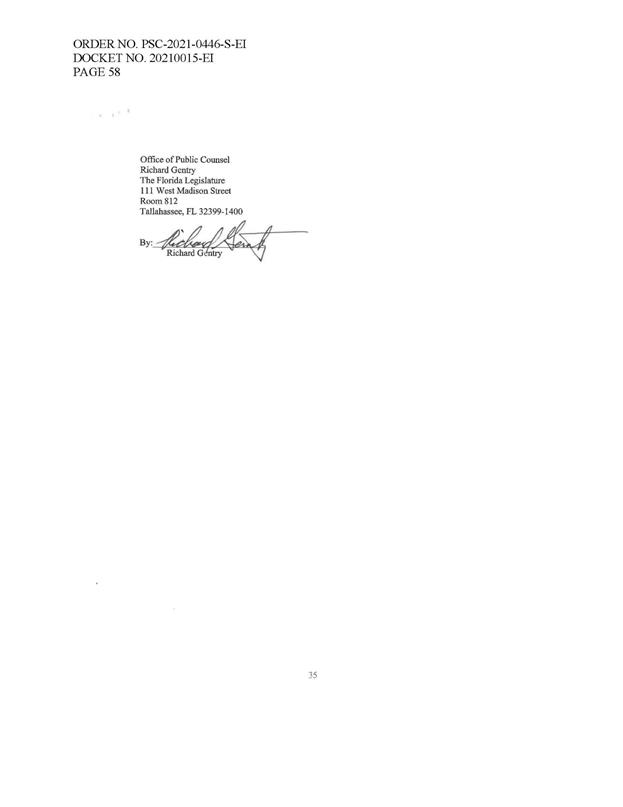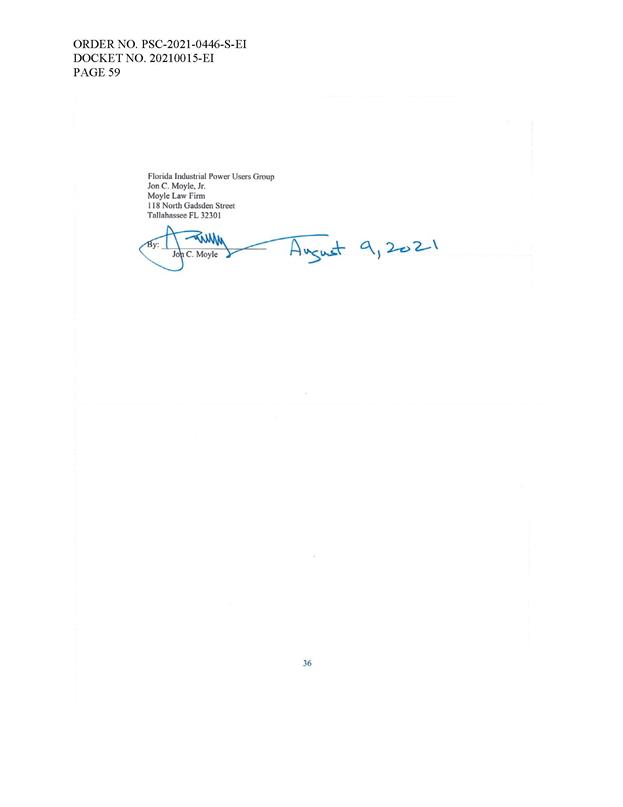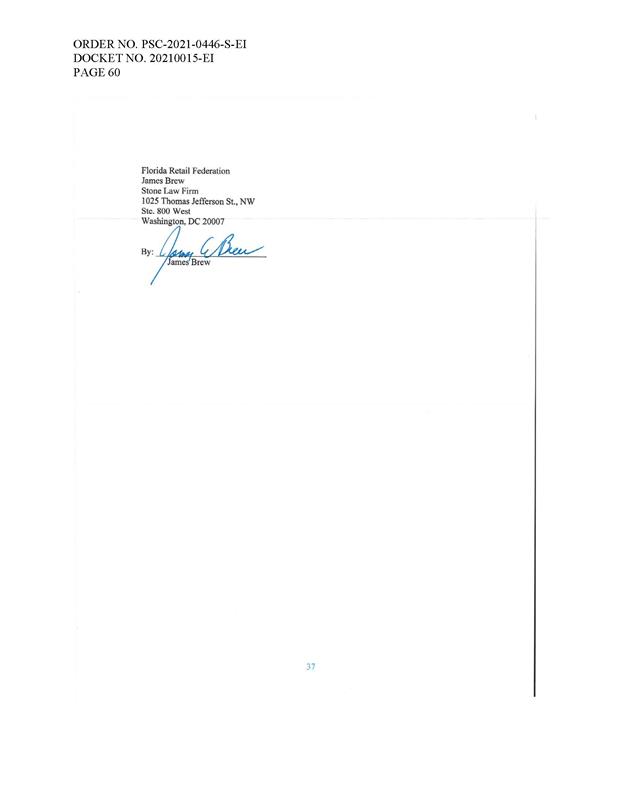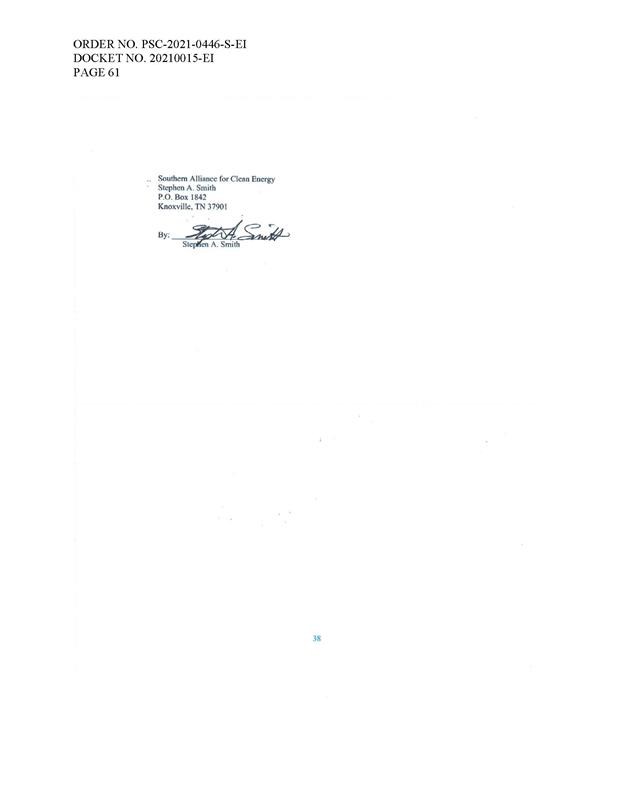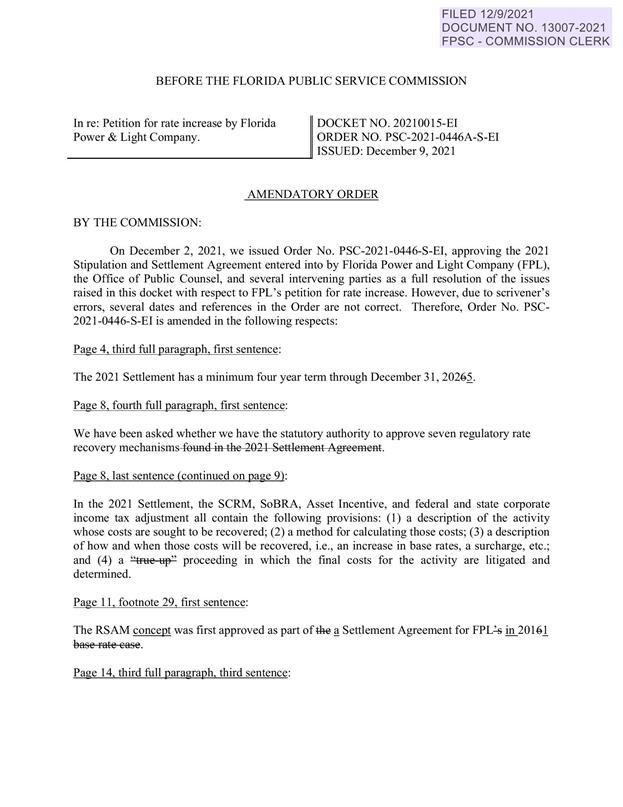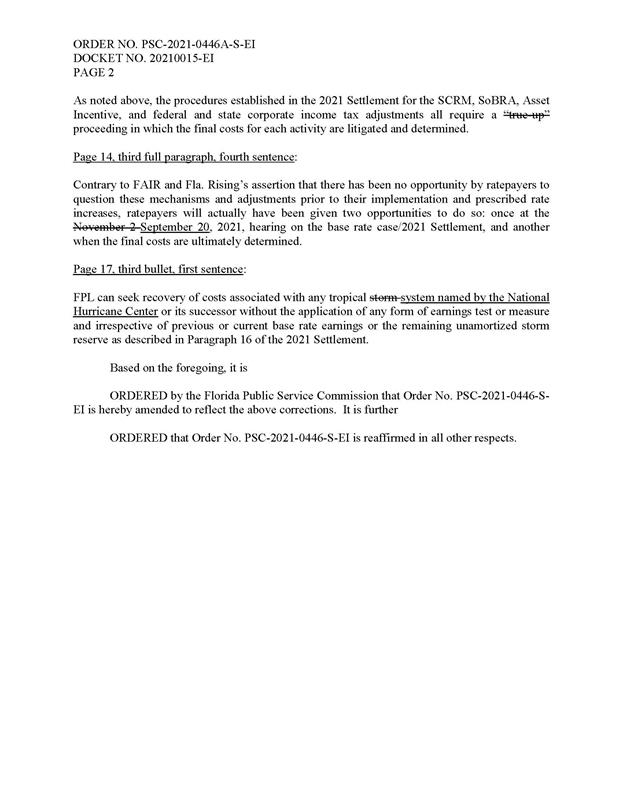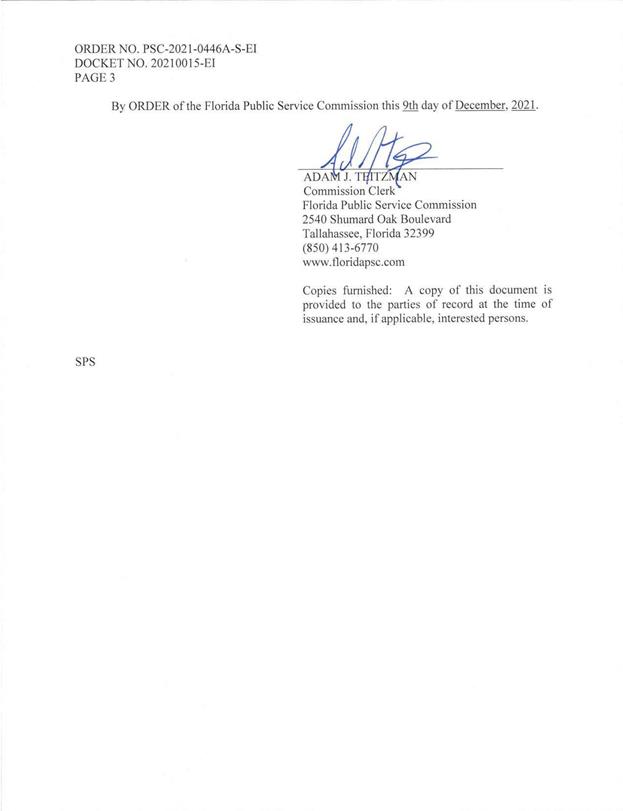BEFORE THE FLORIDA
PUBLIC SERVICE COMMISSION
|
In re: Petition for rate increase by Florida Power & Light
Company.
|
DOCKET NO. 20210015-EI
ORDER NO.
ISSUED:
|
The following
Commissioners participated in the disposition of this matter:
MIKE LA ROSA,
Chairman
ART GRAHAM
GARY F. CLARK
ANDREW GILES FAY
GABRIELLA PASSIDOMO
APPEARANCES:
R. WADE
LITCHFIELD, Vice President and General Counsel; JOHN T. BURNETT, Vice President
and Deputy General Counsel; MARIA J. MONCADA, Senior Attorney, and CHRISTOPHER
WRIGHT, ESQUIRE, Florida Power & Light Company, 700 Universe Boulevard,
Juno Beach, FL 33408
On
behalf of Florida Power & Light Company (FPL).
RICHARD
GENTRY, Public Counsel; PATRICIA A. CHRISTENSEN, Associate Public Counsel;
ANASTACIA PIRRELLO, Associate Public Counsel; and CHARLES REHWINKEL, Deputy Public
Counsel; Office of Public Counsel, c/o
The Florida Legislature, 111 West Madison Street, Room 812, Tallahassee,
Florida 32399-1400
On
behalf of Office of the Public Counsel (OPC).
WILLIAM C.
GARNER, ESQUIRE, Law Office of William C. Garner, PLLC, 3425 Bannerman Road,
Unit 105, #414, Tallahassee, FL 32312
On behalf of
the CLEO Institute Inc. (CLEO).
ROBERT SCHEFFEL
WRIGHT and JOHN T. LAVIA, III, ESQUIRES, Gardner, Bist, Bowden, Dee, LaVia,
Wright, Perry & Harper, P.A., 1300 Thomaswood Drive, Tallahassee, Florida
32308
On behalf of
Floridians Against Increased Rates, Inc. (FAIR).
SCOTT L. KIRK, MAJ, USAF,
AF/JAOE-ULFSC, ESQUIRE, 139
Barnes Drive, Suite 1, Tyndall Air
Force Base, FL 32403
On behalf of the Federal Executive Agencies (FEA).
JON C. MOYLE, JR. and KAREN PUTNAL, ESQUIRES, Moyle Law Firm, P.A., 118 North Gadsden Street,
Tallahassee, FL 32312
On behalf of
the Florida Industrial Power Users Group (FIPUG).
FLOYD R. SELF, ESQUIRE, Berger Singerman, LLP, 313 North
Monroe Street, Suite 301, Tallahassee, FL 32301 and T. SCOTT THOMPSON,
ESQUIRE, Mintz, Levin, Cohn, Ferris, Glovsky and Popeo, P.C., 555 12th
Street NW, Suite 1100, Washington, DC 20004
On behalf
of Florida Internet & Television Association, Inc. (FIT).
JAMES W. BREW and LAURA WYNN BAKER, ESQUIRES, Stone Mattheis Xenopoulos
& Brew, PC, 1025 Thomas Jefferson Street, NW, Eighth Floor, West Tower,
Washington, D.C. 20007
On behalf of Florida Retail Federation (FRF).
BRADLEY MARSHALL and JORDAN
LUEBKEMANN, ESQUIRES, Earthjustice, 111
S. Martin Luther King Jr. Blvd., Tallahassee, Florida 32301 and CHRISTINA I. REICHERT, ESQUIRE, Earthjustice,
4500 Biscayne Blvd., Ste. 201, Miami, Florida 33137
On behalf of Florida Rising, Inc., League of United Latin American
Citizens of Florida, and Environmental Confederation of Southwest Florida, Inc.
(Fla. Rising, LULAC, ECOSWF).
NATHAN
A. SKOP, ESQUIRE, 420 NW 50th Boulevard, Gainesville,
FL 32607
On behalf of Daniel and Alexandria Larson (Larsons).
GEORGE CAVROS, ESQUIRE, Southern Alliance for Clean
Energy, 120 E. Oakland Park Blvd., Suite 105, Fort Lauderdale, FL 33334
On behalf of Southern Alliance for Clean Energy (SACE).
KATIE CHILES
OTTENWELLER, ESQUIRE, Southeast Director, Vote Solar, 838 Barton Woods Road,
Atlanta, GA 30307
On behalf of
Vote Solar.
STEPHANIE U. EATON, ESQUIRE, Spilman Thomas &
Battle, PLLC, 110 Oakwood Drive, Suite 500, Winston-Salem, NC 27103
On behalf of Walmart Inc. (Walmart).
SUZANNE S.
BROWNLESS, SHAW P. STILLER, and BIANCA LHERISSON, ESQUIRES, Florida Public Service Commission, 2540 Shumard Oak Boulevard, Tallahassee, Florida 32399-0850
On
behalf of the Florida Public Service Commission (Staff).
MARY ANNE
HELTON, ESQUIRE, Deputy General
Counsel, Florida
Public Service Commission, 2540
Shumard Oak Boulevard, Tallahassee,
Florida 32399-0850
Advisor
to the Florida Public Service Commission.
KEITH C.
HETRICK, ESQUIRE, General Counsel, Florida Public Service Commission, 2540
Shumard Oak Boulevard, Tallahassee, Florida 32399-0850
Florida
Public Service Commission General Counsel.
SUPPLEMENTAL FINAL ORDER
BY THE COMMISSION:
BACKGROUND
This
proceeding is before us on remand from the Florida Supreme Court.[14] Before
addressing the substance of this remand, we provide the following brief
synopsis of the procedural history of this matter.
This
docket was opened January 11, 2021, when the Florida Power & Light Company
(FPL or Company) filed a letter notifying us that it would file a request for a
base rate increase. On March 12, 2021, FPL filed its petition, minimum filing
requirements, and testimony for a base rate increase effective January 2022.
Numerous parties intervened in this docket and undertook substantial discovery.
One
week prior to the scheduled commencement of the final hearing, FPL and several
intervening parties in this docket (Signatories)[15]
filed a Joint Motion for Approval of Settlement Agreement, with a copy of the
subject Stipulation and Settlement (2021 Settlement). Intervenors Floridians
Against Increased Rates (FAIR), the Environmental Confederation of Southwest
Florida (ECOSWF), Florida Rising, Inc., and League of United Latin American
Citizens of Florida (LULAC) (collectively “Intervenors”) did not join the
Agreement and opposed the Joint Motion for Approval of Settlement Agreement.
On
September 20, 2021, we conducted a final hearing on FPL’s base rate petition as
well as the Joint Motion for Approval of the 2021 Settlement. On December 2,
2021, we entered a Final Order Approving 2021 Stipulation and Settlement
Agreement.[16] On December
9, 2021, we entered an Ordering Amending that Final Order to correct several
non-substantive scrivener’s errors relating to dates and references.[17] This
Order and Order No. PSC-2021-0446-S-EI will be referred to collectively as “the
2021 Final Order” in this Order. Copies of these Orders are appended hereto as
Attachments A (PSC-2021-0446-S-EI) and B (PSC-2021-0446A-S-EI).
On
December 28, 2021, FAIR timely filed an appeal of the 2021 Final Order. On
January 3, Florida Rising, ECOSWF and LULAC (collectively “Florida Rising”)
timely filed their appeal of the 2021 Final Order. The Florida Supreme Court
consolidated these appeals and, on September 28, 2023, remanded this matter for
further proceedings.
We
have jurisdiction over this matter pursuant to the Court’s remand and the
provisions of Chapter 120 and Sections 366.04, 366.05, and 366.06, Florida
Statutes (F.S.).
SCOPE OF REMAND
The
2021 Final Order that was appealed and remanded addressed the numerous issues
raised by the parties in three groups, described as follows:
[1] standing –
whether FAIR’s request to intervene should be granted; [2] jurisdictional -
whether we have the statutory authority to approve proposed rate recovery
mechanisms as part of the 2021 Settlement; and [3] whether the 2021 Settlement
should be approved.
As to the first issue group, no
party appealed or cross-appealed the issue of FAIR’s standing and, accordingly,
it was not the subject of the Supreme Court’s remand. We are not entering
supplemental findings or conclusions regarding FAIR’s standing, and that
section of the 2021 Final Order remains unchanged.
Turning
to the second issue group, the Court did not question our statutory authority
to consider the various tools and accounting approaches set forth in the 2021 Settlement.
Appellants raise other arguments in
opposition to the Commission's approval of the settlement agreement. These
arguments include challenges to the Commission's statutory authority to approve
various pieces of the settlement agreement: the Storm Cost Recovery Mechanism;
the Reserve Surplus Amortization Mechanism; the Asset Optimization Incentive,
which includes the monetization of renewable energy credits; a corporate tax
adjustment; the Solar Base Rate Adjustment mechanism (SoBRA); a construction
incentive for solar generation sites constructed pursuant to SoBRA; and cost
recovery related to the Green Hydrogen Pilot Program and a consummation payment
FPL made to Jacksonville Electric Authority concerning the retirement of a
coal-fired power generation unit. To the extent any of these challenges to the
Commission's statutory authority is preserved, none gives us a reason to set
aside the order under review.[18]
Because the Court found our
stated bases for jurisdiction to be sufficient, we are not entering
supplemental findings or conclusions regarding our jurisdiction to consider the
2021 Settlement, and that section of the 2021 Final Order remains unchanged.
The
only issue the Court remanded to us is whether the 2021 Settlement should be
approved as being in the public interest.[19]
The Court neither affirmed nor reversed our prior conclusion that the 2021
Settlement is in the public interest. The Court did not vacate the 2021 Final
Order. Instead, the Court remanded for a further explanation of our approval,
directing that we specifically address certain matters:
That includes considering [A] the competing arguments made
by the parties below in light of [B] the factors relevant to the Commission’s
decision, and supplying, given these arguments and factors, an explanation of
how the evidence presented led to its decision.[20]
- Competing
Arguments made by the Parties
The
Court identified the arguments forwarded by FAIR, LULAC, and ECOSWF as follows:
1. Need for the rate increases in the
settlement agreement
2. ROE range.
3. Equity-to-debt ratio.
4. RSAM.
5. Rate base investments (SoBRA).
6. Pilot programs (electric vehicle
chargers, Green Hydrogen, Solar Power Facilities.
7. SolarTogether.
8. Minimum bill.
9. Extension of time for recovery of
retirement costs of certain assets.[21]
We have thoroughly reviewed
Intervenors’ Prehearing Statements and Post Hearing Briefs to determine if
there are any additional disagreements between, or arguments raised by, the
parties that were not specifically identified by the Court. We found six
arguments raised before us that were not expressly mentioned in the
above-quoted paragraph. On November 9, 2023, Commission staff conducted an
informal meeting with the parties to this docket who were also parties to the
Supreme Court appeal – Intervenors and FPL – and presented the above list of
arguments. These parties agreed to that list with the following additional
issues:
10. Revenue allocation between classes.
11. FPL system overbuilt.
12. Storm cost recovery mechanism.
13. Federal tax adjustments.
14. Incentive mechanism for asset
optimization.
15. Solar cap cost incentive.
- Factors Relevant to the Commission’s Decision
The
Court identified certain factors that we must
consider in this remand when we address these competing arguments:
The
Legislature has provided that the Commission, in “fixing fair, just, and
reasonable rates for each customer class, ... shall, to the extent practicable, consider the cost of providing
service to the class, as well as the rate history, value of service, and
experience of the public utility; the consumption and load characteristics of
the various classes of customers; and public acceptance of rate structures.” §
366.06(1). The Commission “shall also consider the
performance of each utility pursuant to [the Florida Energy Efficiency and
Conservation Act] when establishing rates for those utilities over which the
commission has ratesetting authority.” § 366.82(10), Fla. Stat. (2021). A reasonably explained decision from the Commission must reflect that those factors have
been considered to the extent practicable.[22]
The Court also noted additional
factors that we may consider in
appropriate circumstances at our discretion:
[T]he
Commission can consider “the
efficiency, sufficiency, and adequacy of the facilities provided and the
services rendered; the cost of providing such service and the value of such
service to the public; the ability of the utility to improve such service and
facilities; and energy conservation and the efficient use of alternative energy
resources.” § 366.041(1),
Fla. Stat. (2021). And the Legislature has
made clear that “it is in the public interest to promote the development of renewable
energy resources in this state.” § 366.91(1),
Fla. Stat. (2021). Evidence that these
factors have been considered—where they are germane to determining whether the
settlement agreement is in the public interest and results in rates that are
fair, just, and reasonable—permits meaningful judicial review of the
Commission’s conclusions.
The Commission can also consider non-statutory factors
if it explains why they are relevant and how they relate to the Commission’s “historical
and statutory role.” Sierra Club, 243 So. 3d
at 911. For example, in the order under
review, the Commission supported its decision by stating that “FPL’s
residential 1,000 kWh bill [is] projected to remain 21% below the current
national average” under the settlement agreement. Assuming that it can explain
the relevance of this metric in light of “the purpose of the Commission,”
id., the Commission can permissibly consider it in making its
decision.[23]
Consistent
with the Court’s direction, we provide below our explanation of how the
evidence presented on the parties’ competing arguments, in light of the
identified factors, leads to our conclusion that approving the 2021 Settlement
is in the public interest. We do so based on the existing record. All aspects
of Order No. PSC-2021-0446-S-EI and Order No. PSC-2021-0446A-S-EI remain
unchanged.
Supplemental Findings and Conclusions
In reviewing a settlement agreement,
we first “make[] factual findings based on the evidence presented by the
parties.”[24] As the
finder of fact, we must “consider all the evidence
presented, resolve conflicts, judge credibility of witnesses, draw permissible
inferences from the evidence, and reach ultimate findings of fact based on
competent substantial evidence.”[25]
Each of those ultimate findings of fact must be based on a preponderance of the
record evidence.[26] The
Florida Supreme Court defines “preponderance of the evidence” as follows:
The
greater weight of the evidence, not necessarily established by the greater
number of witnesses testifying to a fact but by evidence that has the most
convincing force; superior evidentiary weight that, though not sufficient to
free the mind wholly from all reasonable doubt, is still sufficient to incline
a fair and impartial mind to one side of the issue rather than the other.[27]
Our findings of fact regarding the competing arguments presented by the
parties are set forth below.
Issue 1: The need for the rate increases in the Settlement Agreement.
In the original filing, FPL requested a comprehensive
base revenue increase in 2022 of $1.108 billion, a subsequent year adjustment
in 2023 of $607 million, and adjustments in 2024 and 2025 solely for solar
generation (discussed below in Issue 5, Solar Base Rate Adjustment). T. Vol. 1
at 45. Capital initiatives account for most of the requested increases in 2022
and 2023, with inflation, customer growth, and changes in the weighted average
cost of capital also affecting to the total. T. Vol. 1 at 213. The capital
initiatives include improvements to reliability, upgrades and additions to the
generation fleet, and hardening infrastructure. Id.
The 2021 Settlement lowers the rate increases originally
proposed by FPL. The Agreement authorizes FPL to increase its base rates and
service charges effective January 1, 2022, to generate an additional $692
million of annual revenue. The 2021
Settlement further authorizes FPL to increase its base rates and service
charges effective January 1, 2023, to generate an additional $560 million of
annual revenue.
FAIR asserts that the increase proposed in the 2021
Settlement – the largest (by dollar amount) in history for an investor-owned
Florida utility – imposes rates that are unfair, unjust, and unreasonable
because they exceed the level that FPL needs to fulfill its duty of providing
safe and reliable service at the lowest possible cost. FAIR Witness Herndon
testified that FPL can provide services at its current (2021) rates, and that
only modest rate increases during the term of the 2021 Settlement (Settlement
Term) are justified. T. Vol. 12 at 2651-53. Florida Rising argues that FPL’s
rate base has quadrupled in sixteen years (2010-2025) and that the current
increase in base rates reflects this continuing overspending pattern.
Post-Hearing Brief (PHB) at 9.
In support of the need for the requested rate increases,
FPL presented testimony that its 2022 test year jurisdictional adjusted ROE is
projected to be 8.40 percent. T. Vol. 4 at 878 (Fuentes). This ROE is below the
bottom of the currently-authorized ROE range. Id. FPL’s projected 2023 jurisdictional ROE is projected to be 7.03
percent, also below the bottom of FPL’s currently-authorized ranged. T. Vol. 4
at 880-81. Accordingly, continues FPL, the rate increases are necessary to
ensure a fair return within the authorized range.
Additionally, FPL
notes that the base rate increases in the 2021 Settlement represent a $383
million reduction from FPL’s original request for 2022 base rates, and a $45
million reduction from the request for 2023.[28]
FPL argues that even with the rate increases set forth in the 2021 Settlement,
its typical residential customer bills remain twenty percent below the national
average, and will remain stable and predictable over the Settlement Term. T.
Vol. 12 at 2734 and 2793.
The common theme among Intervenors’ arguments is that FPL
can provide reliable service to its customers at a far lower cost than
requested in the 2021 Settlement. FPL’s response is that the entire financial
and capital structure it has proposed – including the base rate increases – is
necessary for it to continue providing current levels of service and value at a
reasonable cost.
Virtually all of the operative provisions of the 2021
Settlement and the projects that are being placed into rate base are not new.[29] With the
exception of the Pilot Programs discussed below under Issue 7 and the minimum
bill, every mechanism in the 2021 Settlement is a continuation, expansion, or
modification of a prior approval. The requested debt to equity ratio is
unchanged. Because FPL is continuing an existing path,[30]
we first examine existing rates and utility operations. While we must pass on
each proposal on its merits on the record before us, an examination of utility
performance under prior approvals can educate our decision-making.
In making this observation, we are guided by Section
366.06(1), F.S.:
In fixing fair, just, and reasonable rates for each
customer class, the commission shall, to the extent practicable, consider the
cost of providing service to the class, as well as the rate history, value of
service, and experience of the public utility; the consumption and load
characteristics of the various classes of customers; and public acceptance of
rate structures.
In this same statute, the Legislature has directed us to
“consider the cost
of providing service to the class, as well as . . . the value of service.”[31]
Because Chapter 366, Florida Statutes, does not define “cost” or “value,” we
look to dictionary definitions to ascertain the plain and ordinary meaning of
“cost” and “value.” [32] “Cost” is defined as “the amount or equivalent paid or charged for something.”[33]
“Value” is defined as “relative worth, utility, or
importance.”[34]
The evidence in this record demonstrates that FPL has
delivered value to its customers at a relatively low cost. Residential rates
remain well below the national average[35]
and below those charged by other Florida investor-owned-utilities. The
capabilities of the FPL fleet, while characterized by Florida Rising as
“overbuilt,” result in lower operation and maintenance expenses and a high
degree of reliability[36] while
maintaining relatively low base rates. And while FAIR Witness Mac Mathuna
offered an expert opinion that FPL could deliver this same reliable and safe
service at lower rates than those requested in the 2021 Settlement,[37] we find
more persuasive the evidence presented by FPL that the rate increases proposed
in the 2021 Settlement Agreement are needed to maintain an ROE in the authorized
range, are based on a sound analysis of current and projected conditions in
light of historical performance, and result in rates that are fair, just, and
reasonable.[38] We also
note that these amounts were reduced from the original ask and are the result
of compromise among the Signatories.
Issue 2: Return on Equity Range
The 2021 Settlement sets the regulatory return on common
equity (ROE) at 10.6 percent for all purposes, with an authorized ROE range of
9.7 percent to 11.7 percent. This range is
90 basis points below the request contained in FPL’s original rate filing. If,
at any time during the Term, but no more than once during the Term, the average
30-year United States Treasury Bond yield rate for any period of six
consecutive months is at least 50 basis points greater than the yield rate on
the date that the 2021 Settlement is filed with the Commission (Trigger), after
filing notice with the Commission, FPL’s authorized ROE shall be increased by
20 basis points to be within a range of 9.8 percent to 11.8 percent, with a
mid-point of 10.8 percent. This rate
shall remain in effect from the Trigger date through the remainder of the Term,
for any period in which FPL’s rates continue in effect after December 31, 2025,
and/or until a final order is issued in a future proceeding changing FPL’s
rates and its authorized ROE.
Florida Rising contends that this ROE is out-of-step with
national trends. Citing the testimony of OPC Witness Woolridge, Florida Rising
notes that the average authorized ROE for electric companies from 2000-2020
have slowly decreased from 12.5 percent to 9.39 percent. T. Vol. at 1186.
Florida Rising also notes that we approved a 9.85 percent ROE
mid-point for Duke Energy Florida[39] and
9.95 percent for Tampa Electric Company[40] in rate
cases filed the same calendar year as FPL’s.[41]
FAIR
argues that a fair and reasonable ROE for FPL would be between 8.50
percent and 9.55 percent, depending on the corresponding capital
structure (equity to debt ratio). FAIR Witness Mac Mathuna’s ultimate
conclusion is “that the fair and reasonable ROE for FPL should be set at 8.56
percent and that FPL’s equity ratio should be set at 55.4 percent for
purposes of setting FPL’s revenue requirements for 2022.” T. Vol. 12 at 2594.
FPL
argues that its infrastructure risk profile is higher than most other utilities
and that a higher ROE is necessary to attract investment due to this
volatility. One aspect of this risk is created by Florida’s geography and FPL’s
territory. FPL territory includes much of the west and east coasts of the Florida
peninsula and now encompasses the former Gulf territory in the westernmost
portions of the state’s panhandle. This expanse of low-lying coastline makes
FPL’s territory especially vulnerable in the short term to tropical storm
impacts and in the long-term to the effects of sea level rise. T. Vol. 10 at
2273. Based on current climate predictions, this risk is expected to increase.
T. Vol. 10 at 2281. Additionally, nearly 40 percent of
FPL’s customer accounts – 5.6 million – are located at the southern tip of the
state in Miami-Dade and Broward Counties, the geography of which heightens
transmission and reliability challenges. T. Vol. 10 at 2272.
Nuclear
generation comprises 22 percent of FPL’s energy mix. T. Vol. 10 at
2272. Investors perceive risk with such generation, and this increased risk
perception in turn requires a higher return to encourage investment.
In
support of the as-filed request, FPL Witness Coyne testified that an ROE in the
range of 10.5 to 11.5 percent would be reasonable based upon his cost of equity
analyses. T. Vol. 9 at 2080. In reaching
this conclusion, Witness Coyne used four modeling methodologies “to provide a
robust analytical framework for determining FPL’s ROE without the undue
influence of any single approach or set of assumptions.” Id. at 2082. Witness Coyne also testified that these models and
their results should be examined in the context of current and projected market
conditions. The global outbreak of coronavirus disease 2019 (COVID-19) and the
measures taken to address it had an immediate and drastic effect on the 2020
economy. Id. at 2090-91. Higher
volatility and uncertainty is expected to persist. Id. at 2093. According to Witness Coyne, actions the Federal
Reserve has taken to address these market uncertainties and stimulus packages
being considered by the United States Congress may increase inflation and cause
interest rates to spike. Witness Coyne supports the lower ROE set forth in the
2021 Settlement Agreement, though lower than what he recommended, stating that
it “is within the reasonable range” established by his comprehensive modeling
methodologies. T. Vol. 12 at 2767.
Witness
Barrett’s prefiled testimony sets forth in detail FPL’s ability to meet the
unprecedented challenges posed by effects of the global outbreak of COVID-19
based on its financial position. Id.
at 2254-57. Witness Barrett also testified regarding FPL’s continued financial
strength during the recent volatility of utility investments. T. Vol. 10 at
2257. “FPL’s successful financing contrasts with other, lower credit issuers,
who attempted to raise debt but ultimately had to pull their issuances from the
market or saw significant higher spreads.” Id.
at 1158.
The Florida Supreme Court wrote as
follows regarding general considerations applicable to establishing the
boundaries of an appropriate ROE range:
The
rate of return which public utility companies may be allowed to earn is a
question of vital importance to both rate payers and investors. An inadequate
return may prevent satisfactory services to the public and concomitantly
disappoint investors who will look for alternative sources of investment. The
Public Service Commission is given the power to fix the return within certain
limits. That return cannot be set so low as to confiscate the property of the
utility, nor can it be made so high as to provide greater than a reasonable
rate of return, thereby prejudicing the consumer.[42]
In fixing a
reasonable rate of return within this range, we are guided by the
long-established Hope and Bluefield standard.[43]
Under this standard, a reasonable return is one that is commensurate with the
return investors would expect from like investments of comparable risk, is
reasonably sufficient to assure investor confidence that the utility is
financially sound, and is adequate to attract capital on reasonable terms.[44]
Regarding
comparable risk, the preponderance of the evidence demonstrates that FPL’s
infrastructure risk profile is different from most utilities, including those
in the various proxy groups.[45]
Especially with the acquisition of Gulf, FPL’s territory includes appreciable
expanses of low-lying coastline that bring inherent risk. The preponderance of
the evidence demonstrates that this risk is likely to continue to increase over
time due to storm frequency and severity as well as sea-level rise.
Additionally, FPL faces investor uncertainty due to the perceived risks of
nuclear-fueled energy. FPL must have an adequate ROE in order to attract
capital on reasonable terms throughout a multi-year rate plan.
The preponderance
of the evidence demonstrates that the Company’s overall capital structure has
contributed to its ability to provide customers reliable service at reasonable
rates while weathering tropical and financial storms. Continuing this strong
capital structure can assure investors that the utility is financially sound,
which in turn benefits all customers by attracting capital on reasonable terms.
Based on this record, we conclude
that a regulatory ROE of 10.6 percent for all purposes, with an
authorized ROE range of 9.7 percent to 11.7 percent, as set forth in the 2021
Settlement, is appropriate and in the public interest. We note that if the
United States Treasury Bond yield meets the specified thresholds and this ROE
is increased from 9.8 percent to 11.8 percent, base rates will not increase.
FAIR, Florida Rising, and FPL presented the
testimony of numerous, well-qualified experts on this issue.[46] Our
ultimate determination rests in large part on the relative weight we have
afforded the opinions of these experts. “[A] ‘battle of the experts’
has become the norm in modern trials. Courts must resolve the issues upon which
the experts differ; that is their job in the absence of a jury, no matter how
difficult or complex the issue becomes.”[47]
The finder of fact “is free to weigh
the opinion testimony
of expert witnesses,
and either accept, reject
or give that testimony
such weight as it deserves considering
the witnesses' qualifications,
the reasons given
by the witness for the opinion
expressed, and all the
other evidence in the case, including lay testimony.”[48]
In a prior case involving “a divergence of expert opinion as to the proper rate
of return to be granted,” the Florida Supreme Court specifically held that
“[i]t is the Commission’s prerogative to evaluate the testimony of competing
experts and accord whatever weight to the conflicting opinions it deems
appropriate.”[49]
While all witnesses on these issues
are extremely qualified in their areas of expertise and provided comprehensive
analyses and well-reasoned conclusions based on the facts in this record, we
find the testimony of FPL Witnesses Coyne and Barrett in this record to be more
persuasive. Accordingly, we afford their testimony greater weight than the
testimony offered by the other experts in making our specific findings and
reaching our conclusions regarding both ROE and equity to debt ratio (discussed
immediately below).
Issue 3: Equity to Debt Ratio
FPL proposes an equity ratio of 59.6 percent. This equity
ratio is higher than the ratios we approved for TECO (54 percent)[50] and DEF (53
percent)[51]
and above the average for the operating companies in the proxy group.[52] Florida
Rising argues that there is no record evidence to support a higher ratio for
FPL, and argues that our approval should be in the range of 50-55 percent. PHB
at 30.
FAIR Witness Mac Mathuna’s ultimate conclusion is “that the fair and reasonable
ROE for FPL should be set at 8.56 percent and that FPL’s equity ratio should
be set at 55.4 percent for purposes of setting FPL’s revenue requirements for
2022.” T. Vol. 12 at 2594.
FPL’s proposed equity ratio of 59.6 percent is consistent
with the ratios we have approved for FPL over the past twenty years. T. Vol. 10
at 2268. The preponderance of the evidence in this record supports continuing
this ratio. As discussed above, we find that FPL has a unique risk profile, and
the equity to debt ratio is part of FPL’s overall strategy to maintain
financial strength and flexibility. T. Vol. 10 p. 2685.
Many of Intervenors’ factual arguments with respect to
the equity to debt ratio mirror those with respect to the ROE. The remainder
are variations on a common theme: that is, the combination of the equity ratio
and ROE produce rates that are not fair, just, and reasonable. For the reasons
discussed in this Order, we reach the contrary conclusion and find that the
capital structure works as part of the 2021 Settlement Agreement as a whole to
further the public interest and result in rates that are fair, just, and
reasonable.
Issue 4: Reserve Surplus Amortization Mechanism (RSAM)
As part of its original filing in this docket, FPL
submitted a depreciation study performed by FPL Witness Allis. Based on the
application of the parameters resulting from FPL’s 2021 Depreciation Study,
Witness Allis concluded that FPL had a “theoretical reserve imbalance of $437
million.” T. Vol 3 at 731-32. Put plainly, the analysis estimated that FPL had
under-collected from its ratepayers, and had a $437 million theoretical reserve
deficit as a result. Witness Allis explained his conclusion and its import as
follows:
The terms “correct” or “incorrect” and the precision or
exactness that they imply have no application in this context; rather, the
theoretical reserve is an estimate at any given point in time based on the
current plant balances and current life and net salvage estimates. It can
provide a benchmark of a Company’s reserve position, but it should not be
thought of as the “correct” reserve amount.
T. Vol. 3 at 730-31.
FPL then performed an alternative depreciation analysis
using increased plant lives for the St. Lucie Nuclear Plant (60 years to 80
years), all combined cycle generating plants (40 years to 50 years), and all
solar generating plants (30 years to 35 years). T. Vol. 4 at 751. For transmission,
distribution, and general plant functions, FPL adopted the lives and/or net
salvage values from “either the 2016 FPL Rate Settlement or FPL witness Allis’
2021 Depreciation Study whichever results in longer lives and/or higher net
salvage.” Id. Using the alternative
depreciation parameters, FPL has a theoretical depreciation reserve surplus of
$1.45 billion.
A preponderance of the evidence supports use of the
alternative depreciation parameters. The St. Lucie Nuclear Plant extension is
based on a reasonable expectation that the license renewal to be filed in 2021
will be granted. T. Vol. 4 at 752. The Company has a record of above-average
plant performance, plant upgrades, and plans for the potential utilization of
green hydrogen, all of which support extending the life of its combined cycle
facilities from 40 years to 50 years. Id.
at 752-53. Recent data indicate that a 35-year life for solar facilities is
feasible. Id. at 753.
Whereas the theoretical reserve imbalance from the
original depreciation study represented an under-collection, the reserve amount
resulting from utilization of the alternative depreciation parameters
represents an over-collection from the ratepayers. The RSAM is the accounting
tool that governs FPL’s use of this reserve amount. Under the RSAM, FPL uses
the reserve amount to absorb revenues and expenses such that it maintains a
return on equity within its approved range. T. Vol. 11 at 2299. The Company
records the increases and decreases in expenses that have been addressed by the
RSAM in its surveillance reports. Id.
The RSAM operates under numerous conditions and
limitations. The amount to be amortized is capped at $200 million in 2022, but
is discretionary with FPL for each year thereafter. Amortization in each year of the Settlement
Term is subject to the following conditions: (1) for any surveillance reports
submitted by FPL in which its 12-month period ROE would otherwise fall below
the bottom of the authorized range, FPL must amortize at least the amount
necessary to maintain an ROE of at least the bottom of the authorized range;
(2) FPL may not amortize an amount that would result in an ROE greater than the
top of the authorized range for any 12-month period; and (3) FPL must debit
depreciation expense and credit depreciation reserve in order not to exceed the
top of its authorized range. Any
unfunded storm reserve balance must be depleted prior to using the funded
reserve to recover storm costs. During
the Term, FPL must use all of its Reserve Amount to increase its ROE above the
bottom of the ROE range before it may initiate a petition to increase base
rates.
Florida Rising contends that we should not allow FPL to
use the RSAM at its discretion because the Company has earned at the top of its
regulatory range since the original adoption of the RSAM, and that such a
return is not fair and reasonable. FAIR agrees with Florida Rising, and further
argues that the RSAM provisions in the 2021 Settlement allow the transfer of a
customer-created reserve to FPL investors via earnings at the top of the
authorized range. FAIR argues that the RSAM should be limited in its
application to those situations where FPL must utilize it to stay at the
midpoint of its authorized range, and should not be available to earn above the
midpoint.
FPL counters that the RSAM is essential for the Company
to implement a four-year rate plan without the need to seek a change in rates.
The RSAM allows the Company to address unexpected situations and changes in
circumstances.
The RSAM has been in place since 2013 and has been a key
to FPL implementing multi-year rate terms and avoiding multiple rate cases.
During the most recent period (2017-2020) when FPL was operating under the 2016
Settlement, FPL was able to employ the RSAM to react to the 2017 Tax Reform and
Jobs Act and address the unprecedented impacts related to the COVID pandemic
without seeking a rate change. T. Vol. 10 at 2303-04. Even with those
unexpected events, FPL was able to extend the term under its 2016 Settlement
such that the rate increases sought here are effective January 2022 instead of
January 2021. Id. The RSAM has
provided this degree of rate stability since 2013. We find such rate stability,
especially when accompanied by the low base rates as detailed in this Order, to
be in the public interest.[53]
Intervenors
also argue that the RSAM is a financial tool that is essentially a “slush fund”
used by FPL to maintain earnings at the top of its range, and that such an
application of this mechanism is not in the public interest. The RSAM is used to respond to events and expenses not
anticipated in the normal course of business. Day-to-day utility operations are
generating revenues, and the combination of any number of factors in those
operations can result in higher (or lower) earnings.[54] The RSAM can (and does)
serve as a tool to address the unexpected as FPL implements its plans over
time. In that manner, the RSAM may indirectly contribute to higher earnings.
Issue 5: Rate base investments – SoBRA
The 2021 Settlement authorizes FPL to construct 1,788
megawatts (MW) of solar facilities projected to go into service in 2024 and
2025 or within one year following expiration of the minimum term. These
projects are subject to an installed cost cap of $1,250 per kilowatt of AC
power (kWAC), less the cost of any land component
allocated to such projects when the land is already included in rate base as
Plant Held for Future Use. If leased
land is used to construct a project, the lease expense will be converted to a capital
cost surrogate in accordance with Commission precedent and used to measure
performance against the $1,250 per kWAC price cap.
FPL is authorized to make Solar Base Rate Adjustments
(SoBRA) during the Settlement Term to recover the costs of these projects. FPL
must file a request for cost recovery approval of the subject solar generation
project in the Fuel and Purchased Power Cost Recovery Clause in the year before
that project goes into service. T. Vol. 2 at 483. In that proceeding, the
Commission will consider whether FPL’s cumulative present value of revenue
requirements (CPVRR)[55] is lower
with the generation project than without, and will also determine the
associated adjustments to rates and riders.
For each solar project that is approved for cost
recovery, FPL’s base rates will be increased by the incremental annualized base
revenue requirement (excluding any land component that is already included in
base rates as Plant Held for Future Use) for the first 12 months of operation,
but such recovery will not commence before the entire solar project is in
service. Battery storage can be paired
with the solar projects so long as the total cost remains below the $1,250 per
kWAC cap and the project is cost effective.
Florida
Rising contends that we are without authority to approve this mechanism for two
reasons. First, Florida Rising argues that to approve future rate increases
based on planned construction of solar facilities violates Section 366.06, F.S.
Second, Florida Rising argues that interim rate increases are allowed under
Section 366.07, F.S., only upon a showing by the utility that it is not earning
within its range of return. PHB at 45. The gist of both arguments is Florida
Rising’s contention that we must conduct a hearing and make an appropriate
determination at the time we allow interim rate hikes, and that to do so in
advance violates the cited statutes and is illegal.
The
Florida Supreme Court did not remand this matter for us to reconsider our
authority to approve the SoBRA mechanism. Accordingly, we limit our discussion
to whether approval of this mechanism is in the public interest in light of the
factors identified by the Court in its remand.
The
SoBRA mechanism was contained in the settlement agreements that we approved to
resolve the FPL rate cases in both 2012 and 2016.[56]
This mechanism allows FPL to increase
cost-effective solar incrementally over a defined period, with concurrent,
gradual increases to rate base. Implementation of the SoBRA-based solar program
has provided savings to customers while bringing a considerable number of solar
projects into service.[57] This
increase in solar generation furthers Section 366.91(6), F.S., which provides:
The Legislature finds that it is in the public
interest to promote the development of renewable energy resources in this
state. Renewable energy resources have the potential to help diversify fuel
types to meet Florida’s growing dependency on natural gas for electric
production, minimize the volatility of fuel costs, encourage investment within
the state, improve environmental conditions, and make Florida a leader in new
and innovative technologies.
The opportunity for FPL to add solar
generation during the Settlement Term furthers legislative intent to promote
the development of renewable energy resources, to diversify the types of fuel
used to generate electricity, and to improve environmental conditions. The rate
increases that accompany the addition of this generation are gradual and
predictable, thereby supporting rate stability over the Term
Issue 6: SolarTogether expansion
We
approved the SolarTogether program (Phase I) the year before this rate case was
filed by Order No. PSC-2020-0084-S-EI.[58]
This Order approved a Settlement Agreement executed by FPL, the Southern
Alliance for Clean Energy, Vote Solar, and Walmart, Inc., and supported by
amicus curiae Duke Energy Florida, LLC. Generally stated, SolarTogether
is a voluntary program that provides FPL customers the opportunity to subscribe
to a portion of new solar capacity built through the program by paying a
subscription charge. This subscription charge (or fee) reflects the revenue
requirement associated with constructing the solar facilities, and is recorded
by FPL in base revenues as sales from electricity. Those participants will
receive a subscription credit representing a portion of the system savings
produced by that solar capacity. The credit will be recovered through the Fuel
Clause.
The
original approved size of the program (Phase I) is 1,490 MW, consisting of 20
individual solar power plants sized at 74.5 MW each. The 1,490 MW capacity is
allocated 75 percent (1,117.5 MW) to commercial, industrial, and governmental
customers and 25 percent (372.5 MW) to residential and small business.
Customers may elect a subscription level equivalent to the capacity that would
generate up to 100 percent of their previous 12 months’ total kilowatt-hour
usage, subject to capacity availability. Participation in the Program is
voluntary. The 1,490 MW of solar generation is projected to save customers $249
million. FPL estimates that 55 percent of the projected program benefits will
flow to participants and 45 percent to the general body of customers.
The 2021
Settlement[59] proposes
to expand the program by an additional 1,788 MW at FPL’s discretion through
2025 such that the total capacity of SolarTogether would equal 3,278 MW. The 1,788 MW of incremental capacity will be
allocated 40 percent to residential and small business customers (45 MW
reserved for low-income participants) and 60 percent allocated to commercial,
industrial, and governmental (20 percent of this commercial, industrial, and
governmental capacity is reserved for participants located in the former Gulf
territory). The allocation of benefits remains the same at 55
percent to participants and 45 percent to the general body of customers. The
program is designed such that participants will receive 55 percent of
the program benefits ($357 million), realizing full pay-back of their
subscription fees by year 7, while paying 103.26 percent of
the program’s revenue requirements. The general body of ratepayers will receive
45 percent ($292 million) of the program benefits and pay no
subscription fee. Of this amount, $95 million is fixed.[60]
Florida Rising contends that the program allocations in
the program, as modified in the 2021 Settlement’ are discriminatory in that
they do not match actual power consumption by FPL customers. Specifically, Florida
Rising notes that residential consumption makes up 63 percent of FPL energy
sales, yet residential customers are allocated less than that share in the
current proposal. PHB at 57; T. Vol. 13 at 2866. Another feature of the
SolarTogether program contested by Florida Rising involves the calculation of
credits to those who participate in the program and benefits to the general
body of ratepayers. Specifically, Florida Rising contends that the benefits to
participants are much greater than those realized by non-participants, and are
subsidized by the general body of ratepayers. Finally, Florida Rising also
argues that FPL’s projections are skewed and SolarTogether is not a
cost-effective way in which to construct the planned solar.
FPL’s overarching response to the specific arguments
regarding the cost-effectiveness of SolarTogether is that the costs and
benefits must be examined (1) over the life of the program and (2) as compared
to the costs and benefits of continuing to construct non-solar power generation
facilities. T. Vol. 12 at 2746-47 (Witness Bores) and 2787 (Witness Cohen).
Over its life, the SolarTogether extension alone is projected to provide $425
million of CPVRR savings compared to the same time period without
SolarTogether. Coupled with the 2020 SolarTogether (Phase I) approval, the
total CPVRR for the program is projected to be $648 million. T. Vol. 12 at
2747.
FPL estimates 55 percent of the projected benefits will flow to participants
and 45 percent to the general body of customers.
Our
initial approval of SolarTogether by Order No. PSC-2020-0084-S-EI expressly
contemplates the possibility of FPL proposing an “FPL SolarTogether Phase II.”[61] The
preponderance of the evidence demonstrates that this expansion of SolarTogether
is cost-effective and in the public interest.
FPL
used the same cost-effectiveness analysis for this expansion as it did for the
original program. T. Vol. 12 at 2746. This analysis basically compares the FPL
fleet with and without the additional proposed solar generation, and supports
the conclusion that the total CPVRR of the extended program is $648 million.
Witness Bores convincingly demonstrated that the calculations offered by
Florida Rising in support of their claim of an unduly discriminatory rate
structure were based on a flawed assumption. T. Vol. 12 at 2765. We find the
comprehensive analysis performed over the life of the extended SolarTogether
program under the direction of FPL Witness Bores and its conclusion regarding
CPVRR benefits to be more persuasive than mathematical snapshots offered by
Florida Rising as impeachment of that analysis.
Further,
we find the allocation
of 55 percent of these projected benefits to participants and 45 percent to the
general body of customers to be in the public interest and, as discussed below,
to be part of a framework that results in fair, just, and reasonable rates. We
also find that SolarTogether fairly
distributes the new solar generation among classes, with Phase II increasing
availability for residential and small business customers. Because
SolarTogether fairly distributes generation and benefits among ratepayers, we
reject Florida Rising’s argument that the program is unduly discriminatory.
Finally, as discussed below in the Public Interest
section of this Order, our approval of Phase II of SolarTogether serves
“the public interest to promote the development
of renewable energy resources in this state.”[62]
Issue 7: Pilot programs
Approval
of the 2021 Settlement Agreement authorizes several pilot programs, three of
which are challenged by Intervenors as set forth below.
Electric vehicle chargers
The
Settlement Agreement authorizes six programs related to electric vehicles
(EVs): (1) EVolution, a program to
gather data and better plan for and design future EV investments ($30 million);
(2) public fast charging program,
designed to place utility-owned public EV fast charging stations ($100
million); (3) residential EV charging
services pilot, providing opportunity for residential customers to have an
EV charger installed, owned, operated, and maintained by FPL ($25 million); (4)
commercial EV charging services pilot,
providing opportunity for commercial customers to pay a fixed monthly charge
for EV charging services via Company-owned, operated, and maintained equipment
for fleet vehicles ($25 million); (5) new
technologies and software, designed to evaluate emerging electric
technologies and enhance service and resiliency for customers ($20 million);
and (6) education and awareness, a
suite of programs including school curriculums, promotion at conferences and
gathering, and providing resources about electric options ($5 million). The
EVolution program was presented by FPL in its original request and direct
testimony. The other five programs were added by the 2021 Settlement.
The 2021 Settlement Agreement authorizes FPL to implement
and recover the costs associated with these EV programs. Pursuant to the 2021
Settlement, only the reasonableness of amounts actually expended may be
challenged. The cost of the
infrastructure of the EV programs, including the installation and removal
costs, are included in the jurisdictional rate base until recovered from customers.
This total cost is estimated at $205 million over the Term, with certain
offsets expected. Customer pricing for the commercial EV pilot is designed to
recover all costs and expenses over the life of the assets and to be CPVRR
neutral to the general body of ratepayers over the Term. The revenue
requirements of the public fast charging program will be partially offset by
revenue received under FPL’s tariff approved in Docket No. 20200170-EI, which
establishes a rate for utility-owned public EV fast charging stations.
Florida Rising contends that these EV charging costs do
not belong in rate base because they do not generate or provide electricity to
the general body of customers and are not supported by any cost-benefit
analysis. PHB 20.
Beginning in 1995 and continuing through the present, we
have approved pilot EV programs for several Florida public utilities, including
FPL.[63] While
each program differs in detail, they all serve the same general public interest
goals.
As we have in those prior dockets, we find that
understanding the impacts EVs will have on the local grid is in the public
interest. The programs proposed by FPL are an effective means of gathering this
information.[64]
Specifically, as EV ownership increases, utilities must increase their
awareness of the impacts of EV charging on grid reliability and customer usage
patterns. T. Vol. 12 at 2782. These programs will provide FPL with the data
points needed to plan for these impacts.
Green hydrogen
FPL
is authorized to implement a Green Hydrogen pilot project to evaluate how its
combustion turbine units operate with a hydrogen fuel mix and learn how a
hydrogen fuel production facility can be effectively used on-site with
combustion turbine units. The pilot will
be conducted at the existing Okeechobee Clean Energy Center and a 25 MW
electrolyzer and storage facility will be built there. The estimated cost of this pilot program is
$65 million with a projected in-service date of 2023. This estimated cost is included in rate base
and is subject to challenge at a later date.
Florida
Rising contends that the Green Hydrogen pilot is uneconomic, inefficient, and “ultimately
an attempt by FPL to use its monopoly power to extract R&D rents from
captive rate payers to subsidize its possible entry into wholesale sales of
hydrogen.” PHB 21. Florida Rising Witness Rabago testified that hydrogen is
categorically uneconomic on the scale proposed by FPL, and that even
small-scale usage will be inefficient. T. Vol. 12 at 2961.
FPL Witness Valle
testified that the Green Hydrogen pilot is designed, in part, to address the
“curtailment” problem with solar energy. As detailed by Witness Valle, there is
more instantaneous solar generation available at any given time than there is
instantaneous customer demand. T. Vol 2 at 489. The pilot will use these peaks
of solar energy to split water molecules into hydrogen and oxygen, with the
hydrogen then being used as up to 5 percent of the fuel for one combustion
turbine.
The Green
Hydrogen pilot serves the recognized public interest in developing renewable
energy sources.[65] The
dispute among the parties is whether this proposal is cost-effective. Florida
Rising would have us conclude that this pilot should not be approved because
separating and utilizing hydrogen as a fuel is not currently economic, i.e., cost-effective. We find the
testimony of Witness Valle regarding the potential short and long-term benefits
flowing from this pilot compared to its relatively small costs to be more
persuasive on this issue, and to demonstrate that the Green Hydrogen pilot
furthers the legislative intent to develop renewable energy resources.
Solar power facilities
Under the 2021 Settlement, FPL is authorized to offer a
four-year solar power facilities pilot program where commercial and industrial
customers on a metered rate may elect to have FPL install and maintain a solar
facility on their site for a monthly tariff charge. All project costs and
expenses will be recovered from participants through a fixed monthly charge
over a ten-year term.
Florida Rising argues that this program does not serve
the ratepayers at large and is not in useful service and, accordingly, is not
allowable for inclusion in rate base for cost recovery. PHB at 9. Florida
Rising argues that the provision of this type of solar infrastructure is and
should continue to be addressed by public sector.
This pilot program serves the public interest in solar
generation and energy diversification. Participation is voluntary and all costs
and expenses are paid by participants.
Issue 8: $25 minimum bill
FPL’s customer charge[66]
for residential customers is $8.99 per month. The same charge for small
commercial, non-demand customers is $12.51. The 2021 Settlement provides for
the addition of a new minimum base bill of $25 for all residential and general
service non-demand customers. Under this proposal, any customer whose
volumetric charges and base charge combined are less than $25 for any month
would receive a bill for $25. FPL data indicate that this proposal would apply
to over 375,000 customers.
Florida Rising contends that the minimum base bill
violates the principle of cost causation, which they describe as the principle
“that customers should pay for cost they create, and not more or less, to the
extent possible.” T. Vol. 10 at 2701. Florida Rising also contends that the
minimum base bill discourages customer investment in energy efficiency and
distributed generation.
The purpose of the minimum base bill, as stated by FPL,
is to ensure that all ratepayers contribute their share to fixed system costs.
FPL notes that all ratepayers receive service from the same general
transmission and distribution system, with wires and poles necessarily
connecting high and low usage customers alike. The base charge applicable to
each customer covers only billing, metering, and customer service costs. Zero
usage and low usage customers who pay only the base charge are not contributing
to recovery for fixed transmission and distribution costs and are being
subsidized by the remainder of the ratepayers. T. Vol. 12 at 2798.
We agree that low usage customers and seasonal residents
rely on the same portions of the system as other customers. As the evidence
shows, adding a minimum base bill ensures that those customers contribute to
the costs of that system. T. Vol. 12 at 2799. We find that the minimum base
bill more reasonably allocates fixed costs not covered by the base bill among
all of these customers, and that recovering this amount results in rates that
are fair, just, and reasonable.
Issue 9: Extension of time to recover retirement costs
FPL proposed in the filed rate case to amortize the costs
of retired power plants and transmission facilities over ten years. The 2021
Settlement extends this retirement period from ten to twenty years. Florida
Rising argues that this extension of the amortization period for retired assets
unnecessarily increases costs to ratepayers and results in intergenerational
inequities. Florida Rising Witness Rabago estimated[67]
the total cost of this extension to be $1.4 billion. T. Vol. 12 at 2704.
FPL Witness Bores testified that the extension of the
amortization period allowed for a “significant reduction” in revenue
requirements over the Term. T. Vol. 12 at 2762. As to the intergenerational
argument, Witness Bores stated that the customers who pay for the retirements
over the twenty-year period will realize the benefits of retiring plants in
favor of more-efficient, lower-emission generation. Id. Witness Bores estimated the nominal cost of this extension to
be $600 million, and that customers would be “relatively indifferent” to the
impact of this amount on a discounted basis over the 10- to 20-year period. Id. at 2763; T. Vol. 13 at 2840.
Extending the amortization period from ten to twenty
years reduces the revenue requirements for FPL over the Term. The customers who
will pay these costs over the twenty-year period will be those who realize
benefits from retiring the plants in question and replacing them with upgraded
generation. We find this extension to be fair and to benefit the general body
of ratepayers, while also resulting in rates that are fair, just, and
reasonable.
Issue 10: Revenue allocations between classes
Intervenors argue
that the revenue allocations between classes are flawed because FPL did not
conduct a cost-of-service study and then base its allocations on the results of
that study. Florida Rising Witness Rabago testified that the proposed rate
structure is inequitable, and results in small business and residential
customers subsidizing the electric bills of FPL’s larger, general service
customers. T. Vol. 12 at 2686. Witness Rabago calculated this subsidy to be $1
billion over the Term. Id. at 2688.
FPL Witness Cohen
testified that the revenue allocation under the 2021 Settlement is the result
of a negotiated compromise. T. Vol. 12 at 2796. The resulting revenue
allocation to the residential classes in the 2021 Settlement (59 percent) is
slightly higher than that originally proposed but lower than the allocation we
approved in the 2016 Settlement (66 percent). Witness Cohen stated that this
allocation is consistent with prior settlements and complies with our principle
of gradualism, “which limits the revenue increase for each rate class to 1.5
times the total system average increase, including adjustment clauses, and
provides that no rate class receives a decrease in rate.” Id. Under the 2021 Settlement, the typical residential bill for
customers in the former FPL service area will increase by 2.5 percent over
the Settlement Term as compared to 3.4 percent under the original filing. T. Vol.
12 at 2795.
We find these
revenue allocations to be reasonable. They are consistent with our past
settlement approvals and comply with the principle of gradualism. The overall
impact to the residential rate classes was reduced through the negotiation
process and, as discussed below, results in rates that are fair, just, and
reasonable.
Issue 11: FPL system overbuilt
Florida
Rising contends that FPL’s investments in power plants and
transmission and distribution are excessive and result in an unjustifiable rate
base expansion. Florida Rising specifically contends that the Gulf Clean Energy
Center 8 that FPL is constructing is unnecessary because it increases the
reserve margin and decreases the loss of load probability (LOLP)[68] far
beyond currently-established thresholds. PHB at 11. Florida Rising contends
that the scenarios upon which FPL relies to justify this construction are
unlikely or, in some cases, “absurdist and not worth further responding to.”
PHB at 12. Florida Rising also contends the transmission and distribution
system is overbuilt, pointing specifically to the North Florida Resiliency
Connection (NFRC). The end result, concludes Florida Rising, is that the FPL
system is greatly overbuilt and overdependent on natural gas. PHB at 16.[69]
We
find that the greater weight of the evidence supports approval of the
generation, transmission, and distribution system proposed by FPL. We do not
agree with Florida Rising that FPL’s assumptions are unreasonable. The public
interest dictates that a utility consider a wide range of possibilities in
planning for a reliable system. FPL has done so. The choices the Company has
made to account for contingencies are based on a thorough analysis of the
available data.
We
also do not agree with Florida Rising that the future of FPL is one that is
overly-dependent on natural gas for generation. Natural gas is a reliable and
primary means of providing base load generation. As discussed above, FPL has
committed to a substantial expansion of its solar generation specifically to
address climate change and generation diversity, including the pilot Green
Hydrogen program.
Issue 12: Storm cost recovery mechanism
Under the 2021 Settlement, FPL is allowed to seek
recovery of costs associated with any tropical storm or its successor without
the application of any form of earnings test or measure and irrespective of
previous or current base rate earnings or the remaining unamortized storm
reserve.[70] FPL’s recovery of storm costs on an interim
basis will begin 60 days following the filing of a cost recovery petition and
tariffs and will be based on a 12-month recovery period if the storm costs do
not exceed $4.00/1,000 kWh on a monthly residential bill. Any additional costs exceeding $4.00/1,000
kWh may be recovered in subsequent years(s) as determined by the Commission. Storm related costs subject to interim
recovery will be calculated and disposed of pursuant to Rule 25-6.0143,
F.A.C. The storm reserve will be no less
than $150 million. In the event that FPL
incurs in excess of $800 million of qualifying storm costs in a given calendar
year, it may petition to increase the initial recovery beyond $4.00/1,000
kWh. Storm cost recovery proceedings
shall not be a vehicle for a “rate case” inquiry concerning FPL’s expenses,
investment, or financial results.
Florida Rising contends that the storm cost recovery
mechanism violates Sections 366.06 and 366.07, F.S., because it allows new rate
increases prior to the Commission holding a public hearing and making a
determination regarding “the sufficiency of current recovery structures.” PHB
at 44. FPL responds that the mechanism is squarely within our rate-making
authority, as evidenced by prior approvals, and serves the public interest, as
demonstrated by the mechanism’s successful application over time. PHB at 52.
To the extent these arguments are
directed to our jurisdiction to consider this mechanism, we need not revisit
them. We find that the storm recovery mechanism serves an important public
interest, especially in the context of the four-year rate plan. The ability to
quickly seek approval and begin collecting a surcharge for storm recovery
reduces regulatory lag and creates a more stable post-storm financial
environment. This surcharge is followed by a final true-up hearing to ensure
the correct amounts have been charged and collected. Finally, substantially
affected parties are afforded a point-of-entry to participate in this hearing
and contest the proposed recovery, ensuring that any aggrieved ratepayer has
the opportunity to be heard.
Issue 13: Federal tax adjustment
If permanent federal or state tax changes are enacted
effective for any of the tax years 2022 through the Term, the 2021 Settlement
Agreement allows the base revenue requirement to be adjusted for the impacts of
those changes within the latter of 90 days from when the tax becomes law or the
effective date of the law, but in no instance prior to January 1, 2022. This
adjustment will be made for all retail customers through a prospective
adjustment to base rates. Any effects of
a change in taxes on retail revenue requirements will be flowed back to, or
collected from, customers through the Conservation Cost Recovery Clause on the
same basis as used in any base rate adjustment.
Citing Section 366.07, F.S., Florida Rising contends that
this provision allows for an unlawful “unilateral” adjustment to rates without
a hearing and determination that FPL is earning below its authorized allowable
range of return.
To the extent these arguments are directed to our
jurisdiction to consider this mechanism, we need not revisit them.
Allowing an adjustment to the revenue requirement to
account for a tax change without the need for a full rate case is in the public
interest. Any decrease can be quickly flowed to the ratepayers. Any upward
adjustment allows FPL to keep its earnings at the level we are approving in
this Order, which will in turn allow the Company to continue providing service
at present-day cost and value. We review any such changes and corresponding
adjustments when FPL files a petition seeking approval for its proposed
treatment of tax changes. Substantially affected persons – ratepayers – would
have a point-of-entry at that time to present any evidence and argument
regarding the proposed treatment.
Issue 14: Incentive mechanism for asset optimization
We first approved FPL’s asset optimization program as a four-year
pilot as part of the 2012 Settlement in Order No. PSC-2013-0023-S-EI.[71] The
program was designed to allow FPL to create gains through electric wholesale
purchases and sales,[72] and asset
optimization. T. Vol. 4 at 794. Allowable asset optimization under the pilot
included gas storage utilization, production gas sales, capacity release of gas
transportation and electric transmission, and asset management agreements.[73] The
overwhelming majority of the value from these activities was to be flowed to
the customers through the Fuel and Purchased Power Cost Recovery Clause (Fuel
Clause), thereby reducing customers’ annual fuel costs. As an incentive to
maximize asset optimization, FPL would be entitled to a share of this added
value if certain thresholds were exceeded. The Florida Supreme Court affirmed
our Order approving the 2012 Settlement, specifically upholding our approval of
the pilot incentive program.[74]
At the end of
the initial pilot’s term, we authorized FPL to continue the program, subject to
certain modifications, in Order No. PSC-2016-0560-AS-EI.[75]
Under the program as modified in 2016, customers receive 100 percent of the
first $40 million in savings realized from listed activities. T. Vol. 4 at 798.
For all savings between $40 and $100 million, customers receive 40 percent and
FPL receives 60 percent. For all savings above $100 million, FPL and its
customers each receive 50 percent. Id.
From 2013-2022, after netting out incremental O&M expenses, the program has
resulted in a total benefit of $406.7 million. T. Vol. 4 at 800. Of this total,
customers received $354.5 million (87 percent). FPL received $52.2 million (13
percent). Id.
Pursuant to the 2021 Settlement, the program is modified
to apply to all fuel sources (not gas only) when it is reasonable and in the
customers’ best interests based on system requirements, market demand, and the
current market price of fuel or capacity. This includes renewable energy
credits (RECs), which may be monetized and sold. Three annual savings
thresholds are set: (1) FPL customers will receive 100 percent of the incentive
mechanism gain up to $42.5 million; (2) FPL customers will receive 40 percent and
FPL will receive 60 percent of incremental mechanism gains between $42.5
million and $100 million; and (3) FPL and its customers will each receive 50
percent of incremental mechanism gains in excess of $100 million. The per-MWh variable power O&M rate is
set at $0.48/MWh. Optimization
activities, variable power plant O&M rates, and savings thresholds will be
considered “adjustable parameters” that FPL can request be reviewed and
adjusted every four years in the Fuel Clause docket. Expenses, including
incremental O&M costs, personnel, software and association hardware costs,
will be recovered from customers through the Fuel Clause. T. Vol. 4 at 799.
Florida Rising contends that this program seeks recovery
of costs that are not related to the generation, transmission, or distribution
of electricity, that the savings from activities under the program are required
to be kept in a separate account pursuant to Section 366.05, F.S., and,
therefore, “the Commission does not have the legal authority to approve the
mechanism.” PHB at 41.
The Supreme Court affirmed our approval of this program
as a pilot,[76] and
subsequently confirmed our jurisdiction to approve the current mechanism.[77] We are
well within the bounds of our the legal authority in approving the amended
program because the allowable activities – the purchase and sale of power, the
creation and monetization of RECs, the sale of unneeded transmission rights,
and the sale of gas, gas transportation, and gas storage – all involve the
generation, transmission, or distribution of electricity, whether by gas or
another fuel source.
We do not somehow lose the authority to approve the
mechanism because FPL is not maintaining the savings in a separate account, as
maintained by Florida Rising. The requirement to maintain separate accounts is
found in Section 366.05(2), F.S., which provides in part:
Every public utility, as
defined in s. 366.02 which in addition to the production, transmission,
delivery or furnishing of heat, light, or power also sells appliances or other
merchandise shall keep separate and individual accounts for the sale and profit
deriving from such sales.
The prescribed
activities in the program do not involve the sale of appliances or other
merchandise. We conclude that this subsection is not applicable to the
incentive program.
Turning to the Settlement Agreement, the modest proposed
changes to the incentive program do not change its basic structure and
operation. The program is reasonably expected to continue to provide savings
through the efficient use of existing assets.[78]
The history of the program demonstrate that the overwhelming savings realized
from Company actions have and will be flowed to the ratepayers. The amended
thresholds continue to provide appropriate customer benefit and Company
incentive. The inclusion of all fuel
types – and renewable energy credits – in the program will allow it to evolve
with the energy landscape and bring more customer benefit.
We find that the incentive program has and will continue
to provide substantial benefit to the ratepayers and appropriate incentives to
the Company, and is in the public interest. With the newly-approved program now
applying to all fuel types, we find it appropriate for the incentive program to
be administered through the Fuel Clause as set forth in the Settlement
Agreement.
Issue 15: Solar cost cap incentive
The
Settlement Agreement contains another incentive, this one found in the SoBRA
program and referred to as “the solar cost cap incentive.” Florida Rising
contends that this incentive provides FPL an illegal bonus payment over the
“actual legitimate” cost of the installed facility. PHB at 43. It argues that
100 percent of any savings, not just the 75 percent under this incentive
program, must be credited (or never charged) to the ratepayers.
Under
the solar cost cap incentive, if the actual installed cost for any SoBRA project
is less than the $1,250 kWAC cap or adjusted cap, customers and FPL
will share the difference between the actual cost and $1,250 kWAC
cap, or adjusted cap, with 75 percent of the difference benefiting customers
and 25 percent of the difference benefiting FPL. The lower installed cost shall be the basis
for the full revenue requirements and a one-time credit will be made through
the Capital Cost Recovery Clause (CCRC).
In order to determine the amount of this credit, a revised SoBRA factor
will be computed using the same data and methodology incorporated into the
initial SoBRA factor established under the terms of the 2021 Settlement. In lieu of capital expenditures on which the
Annualized Base Revenue Requirement was based, the calculation of the installed
cost will use the actual installed cost adjusted to reflect the incentive. Going forward, base rates will be adjusted to
reflect the revised SoBRA factor. The
difference between the cumulative base revenues since the implementation of the
initial SoBRA factor and the cumulative base revenues that would have resulted
from the revised SoBRA factor had it been in place during the same period will
be credited to customers through the CCRC with interest at the 30-day
commercial paper rate.[79]
FPL
notes that the revenue requirement related to the SoBRAs is based on “the base
revenue requirements for the first twelve months of operation of the
cost-effective solar projects,” such that any reduction realized by virtue of
the incentive will also reduce the revenue requirement. T. Vol. 12 at 2722.
Thus, the operation of the cost cap will never cause an increase of additional
revenues from the SoBRAs above the estimated $140 million annually in 2024 and
2025.
No
matter if it is labeled an “illegal bonus” or “incentive,” we look to the
substance and operation of this provision to determine whether it should be
approved. The provision is designed to encourage FPL to construct solar
facilities in the most cost-efficient manner. It works in coordination with the
overall efforts of FPL to ensure all equipment and contractors are subject to a
competitive bidding process in order to produce the lowest cost.[80] The
ratepayers ultimately benefit by both the lower overall cost and the shared
savings. The greater weight of the evidence demonstrates that providing this
incentive promotes the construction of cost-efficient solar generation and is
in the public interest.
THE PUBLIC
INTEREST
After
making factual findings, the second step in our analysis of a settlement
agreement is for us to “decide[] whether the settlement agreement, in light of
[our] findings of fact, is in the public interest and results in rates that are
fair, just, and reasonable.”[81] We review
settlement agreements as a whole to determine whether to approve them as being
in the public interest.[82]
We initially note that
the 2021 Settlement Agreement has been executed by numerous
organizations with distinct and independent interests. The Office of Public
Counsel, Florida Industrial Power Users Group, Florida Retail Federation, and
Southern Alliance for Clean Energy originally joined the Stipulation and
Settlement Agreement. On August 24, 2021, FPL filed notice that additional
parties Vote Solar and the CLEO Institute, Inc. had joined in the Agreement. On
August 27, 2021, FPL filed notice that the Federal Executive Agencies had also
joined the Agreement. While not every party participated in negotiations or
joined in the 2021 Agreement, the organizations who did participate and reached
consensus represent a broad spectrum of ratepayers and interests.
The
ultimate decision of whether a proposed, comprehensive resolution to a rate
case should be approved rests on a determination of whether that resolution
meets the very high threshold of being in the public interest. Even though this
burden is substantial, the public interest remains a threshold. It does not
require that the resolution be best for every ratepayer at all times in all
situations. The question is whether the agreement as a whole is in the public
interest and results in rates that are fair, just, and reasonable, and the
answer is gleaned from the record presented to us.
1. Mandatory factors
In FAIR, the Court highlighted two statutory provisions that we are to
apply to our review of the 2021 Settlement Agreement on remand.
The Legislature has provided that the Commission, in
“fixing fair, just, and reasonable rates for each customer class, ... shall, to
the extent practicable, consider the cost of providing service to the class, as
well as the rate history, value of service, and experience of the public
utility; the consumption and load characteristics of the various classes of
customers; and public acceptance of rate structures.” § 366.06(1). The
Commission “shall also consider the performance of each utility pursuant to
[the Florida Energy Efficiency and Conservation Act] when establishing rates
for those utilities over which the commission has ratesetting authority.” §
366.82(10), Fla. Stat. (2021). A reasonably explained decision from the Commission
must reflect that those factors have been considered to the extent practicable.[83]
As to Section 366.06(1), F.S., we
begin our analysis with consideration of FPL’s capital structure. As previously discussed, the analyses used to support ROE
and equity to debt ratio are sound. We agree with the conclusions of those
analyses that FPL’s geographic challenges and business risk, primary among
other factors, justify the ROE and ratio established in the 2021 Settlement
Agreement. Our approval of a regulatory ROE of 10.6 percent for
all purposes, with an authorized ROE range of 9.7 percent to 11.7 percent, and
equity ratio of 59.6 percent, as set forth in the 2021 Settlement, will ensure
that FPL has adequate and timely access to capital in
order to continue supplying reliable service. We do not agree with the
conclusions of Intevernors’ witnesses that FPL would enjoy the same or similar
access to capital with a lower ROE and restructured equity to debt ratio, and
find the opinions of FPL’s experts supporting this capital structure to be more
persuasive.
As set forth in detail above, this
overall capital structure is supported by mechanisms designed to support a
four-year rate plan. One of those mechanisms is the RSAM. Our approval of the
alternative depreciation study and the RSAM provides FPL with a tool to address
unexpected expense and revenue impacts over the Settlement Term without the need to seek a rate increase. Without the
RSAM, the multiyear rate plan would not be possible, and ratepayers would not
enjoy long-term bill stability. FPL’s use of the RSAM in the unexpectedly
challenging economic environment of the most recent rate period (2016-2020)
evidences how ratepayers benefit by having this mechanism available.
As our findings above demonstrate,
other mechanisms in the 2021 Settlement Agreement also contribute to FPL’s
financial ability to operate under a multiyear rate plan. The storm cost
recovery mechanism addresses unpredictable, but expected, tropical events. The
process established under this mechanism allows FPL to obtain cost recovery in
a timely manner and avoid regulatory lag. The subsequent true-up proceeding
provides us and ratepayers with the opportunity to review incurred costs and
total recovery.
The 2021 Settlement Agreement also
contains provisions specifically designed to keep rates low over the Term. FPL
extended the time to recover the retirement costs of certain plants and
transmission facilities, thereby reducing revenue requirements and, ultimately,
rates. FPL is also continuing, with slight modifications, its incentive
mechanism for asset optimization. This program has already directed $354.5
million to customers. With the current modifications, these monetary benefits
are expected to increase. Finally, FPL has instituted a voluntary solar cost
cap initiative, whereby it self-incentivizes the construction of solar
generation under the SoBRA program at a lower total cost.
Turning specifically to the cost of
service, we note that the class
allocations in the 2021 Settlement are the result of negotiations. Thus, as has
been the case in prior settlements, these allocations are not accompanied by a
separate cost-of-service study. The class allocations, however, were not cut
from whole cloth and presented to us for a first-time review. The 2021 Settlement class allocations are
consistent with prior, approved FPL settlements. Using those settlements and
the recent rate history of FPL using those allocations as the most practical
guideposts, we find that the 2021 Settlement class allocations result in fair,
just, and reasonable rates. We also note that the percentage increases in rates
for residential and small business customer classes are lower in the 2021
Settlement as compared to the original filing, and comply with the concept of
gradualism as discussed above.
The
input we received during the customer service hearings fully supports the
conclusion that FPL has a history of providing excellent service to its
customers. FPL also has a favorable rate history with its customers, with the
typical 1000 kWh residential customer bill being about 10 percent
lower than it was fifteen years ago.[84]
The
expert testimony supports our conclusion that the ROE requested by FPL is
reasonable. Moreover, the requested rate increase amount as well as the ROE
were reduced as a result of a negotiated settlement. Those same negotiations
results in a significant boost in FPL’s commitment to the use and development
of renewable energy resources.
Based
on our consideration of all of the above, we find that the 2021 Settlement,
taken as a whole, is in the public interest, and establishes rates that are
fair, just, and reasonable in accordance with Section 366.06(1), F.S.
The second statute the Court directed us to consider
in our determination of whether the 2021 Settlement should be approved is
Section 366.82(10)¸ F.S. This
provision is found in the Florida Energy Efficiency and Conservation Act
(FEECA), the entirety of which is codified in sections 366.80 through 366.83,
and 403.519, F.S. When enacted in 1980, FEECA required us to adopt appropriate
goals to increase the efficiency of energy consumption. In 2008, the
Legislature amended FEECA to require us to adopt appropriate goals to increase
the development of demand-side renewable energy systems. Pursuant to Section
366.82(6), F.S., we must review the goals of each utility subject to FEECA at
least every five years. We last established goals for FPL in 2019.[85]
Section
366.82(11), F.S., establishes the Commission’s ratesetting authority over utility
energy conservation program costs. Rule 25-17.015, F.A.C., establishes the
energy conservation cost recovery clause (ECCR) as the mechanism for electric
utilities, such as FPL, to seek approval of reasonable energy conservation
expenses.
Pursuant
to Rule 25-17.0021(4), F.A.C., within 90 days of a final order establishing or
modifying goals, each investor-owned electric utility (IOU) must submit for our
approval a Demand Side Management (DSM) plan designed to meet the utility’s
approved goals, including information about the programs proposed within the
plan. We last approved FPL’s DSM plan in 2020.[86]
Intervenors[87] argue that FPL’s
established DSM programs should be reanalyzed and changed in this docket. We do
not agree, and find that these wide-ranging arguments are more appropriately
raised in FPL’s 2024 goal-setting,[88] DSM plan, and the annual
ECCR dockets.
While goals and DSM plans and
programs are generally[89] not subject to reexamination in a base rate case,
FEECA does influence some of the underlying analyses. FPL properly
accounted for incremental DSM in its load forecasts. T. Vol. 2 at 271-72 &
298. Additionally, the resource analyses conducted by FPL in this case followed
and is consistent with our most recent order on conservation goals. T. Vol. 2
at 432-33.
We have considered the record
evidence presented by all parties regarding FEECA as it relates to the issues
that were identified and litigated, and find that the 2021 Settlement Agreement
is in the public interest and establishes rates that are fair, just, and
reasonable, consistent with section 366.82(10), F.S.
2. Case-specific
factors
The Court in remanding this matter
also listed several statutory provisions that “may” be germane to our
disposition. One of the statutes cited by the Court expresses the Legislature’s
intent “that it is in the public interest to promote the development of
renewable energy resources in this state,”[90] and is directly relevant to
our finding that the 2021 Settlement is in the public interest and results in
rates that are fair, just, and reasonable.
The Legislature included both solar
energy and green hydrogen in the definition of “renewable energy” resources.[91] The
2021 Settlement promotes the development of both. Using the SoBRA
mechanism, FPL will construct 1,788 megawatts (MW) of solar generation through
the Term. Phase II SolarTogether directly serves
the purposes outlined in this statute by expanding the program by an
additional 1,788 MW at FPL’s discretion through 2025 such that the total
capacity of SolarTogether would equal 3,278 MW. The pilot solar power program
will make on-site solar available on a voluntary basis to eligible
participants. These approvals are consistent with and further the legislative
public interest direction on renewable energy development. To ensure resulting
rates are fair, just, and reasonable, SolarTogether and the pilot solar program
are funded by program participants. The benefits of SolarTogether are shared
among all ratepayers to ensure that the program is not unduly discriminatory in
favor of either participants or non-participants. SoBRAs are funded by
incremental base rate increases that must be first approved after a hearing to
address cost-effectiveness.
The pilot program for green hydrogen
aligns with this same legislative direction. Intervenors argue that this pilot
should be rejected as ratepayer-funded research and development. This critique
is misplaced. The Legislature has specifically directed that “it is in the
public interest to promote the development of renewable energy
resources.”[92]
“Development” includes “the act, process, or result of developing.”[93] The
statute does not state that the public interest is served only by the
generation of power with renewable energy, which would be the result of successful
development. The process of developing renewable energy is part of promoting
its development, and that is exactly what is accomplished by the Green Hydrogen
pilot.
The Court also stated that we may
consider “the efficiency, sufficiency, and adequacy of the facilities provided
and the services rendered; the cost of providing such service and the value of
such service to the public; the ability of the utility to improve such service
and facilities; and energy conservation and the efficient use of alternative
energy resources.”[94]
FPL
has delivered high value service to its customers at a relatively low cost.
Residential rates are at least 20 percent lower than the national average[95] and below
those charged by other Florida investor-owned-utilities. FPL has lower
operation and maintenance expenses, with the best non-fuel O & M cost
performance in the industry. The framework approved in the 2021 Settlement
Agreement will foster continuation of these efficiencies, consistent with the
legislative direction in Section 366.041(1), F.S.
CONCLUSION
When presented with
a settlement agreement . . . , the Commission’s review shifts to the public
interest standard: whether the agreement – as a whole – resolved all the
issues, “establish rates that were just, reasonable, and fair, and that the
agreement is in the public interest.[96]
Consistent
with this Court’s direction in FAIR,
we have considered each of the parties’ competing arguments. In the final
analysis, however, we are to examine the 2021 Settlement as a whole in making
our ultimate determination. Taken as a whole and as supported by the record,
the 2021 Settlement Agreement addresses and provides a full resolution of all
issues in this docket. That resolution involves, among other compromises,
reductions in proposed rate increases and a lowered ROE as compared to the
as-filed request. Based on the host of compromises, the 2021 Settlement was
signed by most of the parties to this docket. These parties represent a broad
cross-section of ratepayers and interests. Those Intervenors who chose to not
sign the 2021 Settlement Agreement were provided a full and fair opportunity to
contest that proposed resolution consistent with the requirements of due
process.
The
preponderance of the evidence in this record demonstrates that the 2021
Settlement Agreement supports a multi-year rate plan, which in turn benefits
customers and serves the public interest by providing long-term stability and
predictability with respect to base rates. FPL is bringing an appreciable amount
of renewable energy online with the SoBRA mechanism and Phase II of
SolarTogether, and has proposed additional programs to promote the development
of future renewable energy resources consistent with legislative direction. FPL
has built a system that consistently ranks near the top nationally for
reliability. FPL residential customer rates remain among the lowest in the
state and nation.
Based
upon our findings and conclusions above, we conclude that the 2021 Settlement
is in the public interest, and results in rates that are fair, just, and
reasonable.
Based
on the foregoing, it is
ORDERED
by the Florida Public Service Commission that Order No. PSC-2021-0446-S-EI, as
amended by Order No. PSC-2021-0446A-S-EI and supplemented by this Supplemental
Final Order, is affirmed. It is further
ORDERED
that this docket shall be closed.
By
ORDER of the Florida Public Service Commission this
day of ,
.
|
|
|
|
|
ADAM J. TEITZMAN
Commission Clerk
|
Florida Public Service Commission
2540 Shumard Oak Boulevard
Tallahassee, Florida 32399
(850) 413‑6770
www.floridapsc.com
Copies furnished: A copy of this
document is provided to the parties of record at the time of issuance and, if
applicable, interested persons.
SPS
NOTICE OF FURTHER
PROCEEDINGS OR JUDICIAL REVIEW
The
Florida Public Service Commission is required by Section 120.569(1), Florida
Statutes, to notify parties of any administrative hearing or judicial review of
Commission orders that is available under Sections 120.57 or 120.68, Florida
Statutes, as well as the procedures and time limits that apply. This notice should not be construed to mean
all requests for an administrative hearing or judicial review will be granted
or result in the relief sought.
Any
party adversely affected by the Commission's final action in this matter may
request: 1) reconsideration of the decision by filing a motion for
reconsideration with the Office of Commission Clerk, 2540 Shumard Oak
Boulevard, Tallahassee, Florida 32399-0850, within fifteen (15) days of the
issuance of this order in the form prescribed by Rule 25-22.060, Florida
Administrative Code; or 2) judicial review by the Florida Supreme Court in the
case of an electric, gas or telephone utility or the First District Court of
Appeal in the case of a water and/or wastewater utility by filing a notice of
appeal with the Office of Commission Clerk, and filing a copy of the notice of
appeal and the filing fee with the appropriate court. This filing must be completed within thirty
(30) days after the issuance of this order, pursuant to Rule 9.110, Florida
Rules of Appellate Procedure. The notice
of appeal must be in the form specified in Rule 9.900(a), Florida Rules of
Appellate Procedure.




































